
Vegetables in Sailor's Accounts Menu: 1 2 3 4 <<First
Vegetables in Sailors Accounts During the Golden Age of Piracy, Page 4
Vegetables Found In Sailor's Accounts, Continued
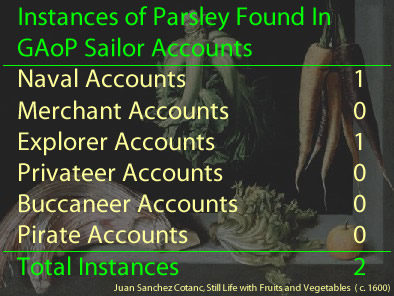
Parsley
(Petroselinum crispum)
Called by Sailors: Porsley, Pursley
Vegetable Type: Salading
Appearance: 2 Times, in 2 Unique Ship Journeys from 2 Sailor Accounts.1
Locations Found in Sailor's Accounts: St. Helena; Timor, Indonesia;
Two sailors mention finding Parsley; William Dampier during a stop on Timor, Indonesia during his exploratory voyage in the fall of 1699 and sailor Edward Barlow aboard HMS Monck when it stopped at St. Helena in 1671. Dampier only notes finding it while Barlow says he found "store of ‘porsely’ growing in the valleys everywhere."2 Parsley would have been familiar to the English which explains why the normally descriptive Dampier didn't say much about it.
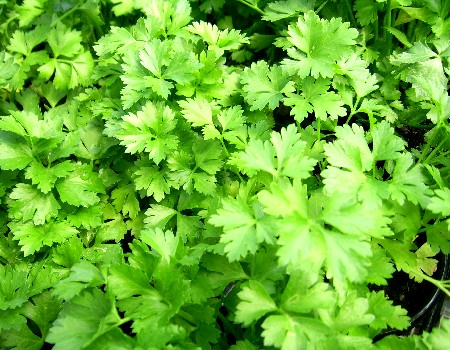
Photo: Marina Shemesh - Flat Leaf Parsley
Botanist John Gerard includes entries for several parsleys including garden parsley, bastard parsley, mountain parsley, stone parsley, water parsley (or smallage) and wild parsley. Of interest here is the garden parsley, which both he and botanist John Parkinson divide into three types: common, curled and Virginia.3 Parkinson explains that "common Parsley is so well knowne, that it is almost needlesse to describe it, having divers fresh greene leaves"4. Gerard is a little more descriptive, noting that parsley leaves are "a beautiful greene, consisting of many little ones fastened together divided most commonly into three parts and also snipt round about the edges"5. Both state that the only difference between common and curled parsley is the curled edges of the leaves. Virginia parsley "hath leaves like the ordinary, but rounder, and of a yellowish greene colour, the stalkes are some three foot high, divided into sundry branches wheron
grow umbells of whitish floures"6. (This sounds like what is today called Italian Parsley.)
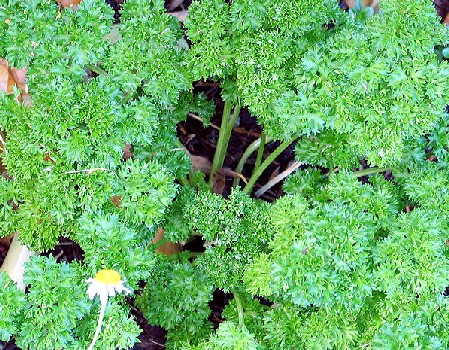
Photo: Donovan Govan - Curly Leaf Parsley
French botanist Louis Lémery says "Parsley is a Plant much used in the Kitchin"7. He recommends gathering parsley leaves before the plant flowers, "for then they are most tender, have a better smell, and are less sharp."8 Parkinson agrees that parsley leaves are widely used, being "boyled, roasted, fryed, stewed, &c. and being greene it serveth to lay upon sundry meates, as also to draw meate withall. It is also shred and stopped [stuffed] into poudered beefe, as also into legges of Mutton, with a little beefe suet among it, &c."9 Gerard adds that parsley "leaves are pleasant in sauces and broth, in which ...they give a pleasant tast"10.
Lémery also says that the roots are used in food, with the best roots being "long, big, whitish, tender, and of good taste."11 Parkinson recommends putting the roots in broth as well as "boyled or stewed with a legge of Mutton, stopped with Parsley as aforesaid, [it] is very good meate [food], and of very good rellish, as I have proved by the taste: but the rootes must bee young, and of the first yeares growth"12 .
Humorally, "Garden Parsley is hot and dry, but the seed is more hot and dry, which is hot in the second degree, and dry almost in the third: the root is also of a moderate heate."13 The Paracelsian Principles included "much
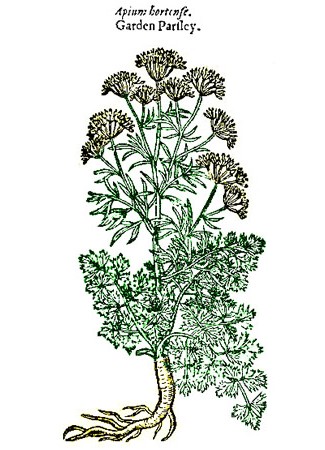
Garden Parsley, From The Herball or General Historie of Plantes,
By John Gerard
(1636)
sharp Salt, and an indifferent
quantity of fine Oil." It agrees with "those that are of a phlegmatick [cold and wet] and melancholy [cold and dry] Temper[ament]; but young Persons of an hot
and bilious Constitution, ought to use it very
moderately."14
Lémery adds a rather curious observation about the salt principle it contains:
Parsley contains so sharp and corroding a Salt, that when you wash a Glass in the Water wherein Parsley has been washed before, and where some part of the Leaves still remain, do all you can to save the Glass, it will break in pieces; and this proceeds because this Salt being of an uneven and very sharp edged Superficies, as it passes and repasses the parts of the Glass it breaks it in the same manner as a Saw, whose edge is uneven and jagged, as well as that of the Salt of Parsley cuts a solid Body, wherewith it is sawed.15
He suggests that this cutting action would make swallowing the vegetable remove obstructions from the alimentary canal. Similarly, Parkinson says that it opens "obstructions of the liver, reines [kidneys], and other parts, helping much to procure urine."16 Gerard suggests that parsley seeds "are more profitable for medicine [than the leaves]; they make [fluids] thinne, open [internal passages], provoke urine, dissolve the [kidney] stone, break and wast away winde, are good for such as have the dropsie, draw downe menses, bring away the birth, and after-birth: they be commended also against the cough, if they bee mixed or boiled with medicines made for that purpose: lastly they resist poisons, and therefore are mixed with treacles."17
1 Edward Barlow, Barlow's Journal of his Life at Sea in King's Ships, East and West Indiamen & Other Merchantman From 1659 to 1703, p. 199; William Dampier, A Continuation of a New Voyage Round the World, Vol III, 1709, p. 73; 2 Barlow, p. 199; 3 John Gerard, The Herball or General Historie of Plantes, 2nd ed, 1636, p. 1013 & John Parkinson, Paradisi in Sole, Paradisus Terrestris, Reprinted from the Edition of 1629, 1904, p. 491-2; 4 Parkinson, p. 491; 5,6 Gerard, p. 1013; 7 Louis Lémery, A treatise of foods in general, 1704, p. 87; 8 Lémery, p. 86; 9 Parkinson, p. 492; 10 Gerard, p. 1014; 11 Lémery, p. 86; 12 Parkinson, p. 492; 13 Gerard, p. 1014; 14,15 Lémery, p. 87; 16 Parkinson, p. 492; 17 Gerard, p. 1014
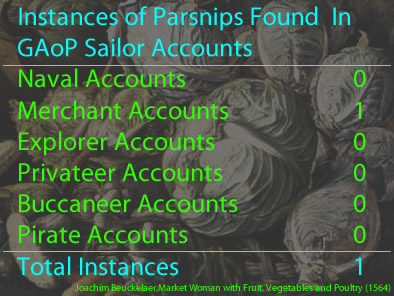
Parsnips
(Pastinaca sativa)
Called by Sailors: Parsnip
Vegetable Type: Root
Appearance: 1 Time, in 1 Unique Ship Journey from 1 Sailor Account.1
Locations Found in Sailor's Accounts: Cape of Good Hope, Africa;
Parsnips appear only in sailor Edward Barlow's accounts. He saw them at the Cape of Good Hope while a prisoner of the Dutch vessel Burff van Linden, which stopped there in 1674. It is one of several root vegetables he mentions finding there. During the golden age of piracy they could also be found on some of common English provisioning islands in the Caribbean, Juan Fernandez and Jamaica. Parsnips were likely consumed by some of the sailors who stopped in those places even if they didn't mention them.
Parsnips are closely related to carrots and parsley and, although their history is not as clear as some other vegetables, they are said to have originated in Eurasia.2 Most of the botanists from
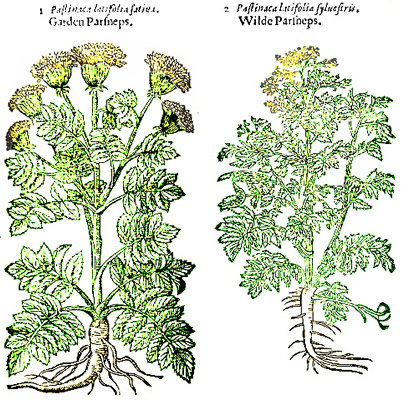
Wild and Garden Parsnips, From The Herball or General Historie of Plantes,
By John Gerard
(1636)
around the period divide parsnips into two types: garden and wild. John Parkinson describes the parsnip root as "long, great and white"3, while John Gerard says the wild parsnip root is "small, hard, wooddy, and not fit to be eaten."4 Parkinson identifies another type of garden parsnip, which sounds like a cultivar rather than a unique type. He refers to it as a pine parsnip with a root like the regular garden parsnip, except "not so long, but thicker at the head and smaller below"5.
French botanist Lewis Lémery says, "Parsnip is a Root well known, and much used for Food." When selecting parsnips to eat, he recommends selecting a garden parsnip over a wild one, "because 'tis thicker, more tender, and of a much more agreeable Taste and Smell."6 Although Gerard warned against eating wild parsnips, he does note that when their seeds are "brought into the garden, and sowed in fertill ground, [they] do prove better roots, sweeter and greater than they that are sowne of seeds gathered from those of the garden."7 Parkinson likewise recommends garden parsnips as being "very pleasant to bee eaten, and the more pleasant if it grow in a fat sandy soyle."8 He adds that his pine parsnip "is not altogether so pleasant"9. Noted period author on vegetables Thomas Tryon warns, It is not good to keep this Root above a day or two before ‘tis us’d, for then they’ll prove dull upon the Pallat, [and] strong in their taste and smell"10.
Parkinson says that a parsnip is "boyled and stewed with butter", particularly during Lent, "yet it is very good all the winter long."11 Gerard states, "There is a good and pleasant food or bread made of the roots of Parsneps"12,
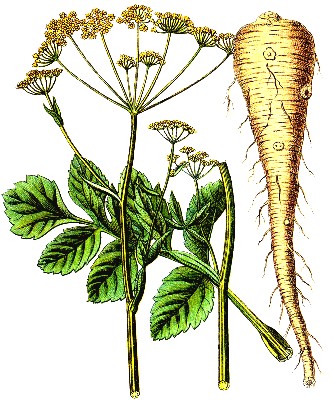
Artist: Jacob Sturm
Parsnip, From Deutschlands Flora in Abbildungen, By Johann
Georg Sturm (1796)
although he doesn't provide any more detail on how they are prepared. Gardener and author John Evelyn says they are boiled, although "being [eaten] cold, is of it self a Winter-Sallet, eaten with Oyl, Vinegar, &c."13
The subject of how beneficial parsnips are comes up frequently in the botanists' and other texts. Tryon says they "breed a grosser kind of Nourishment" than carrots or turnips.14 However his is the only such opinion among the authors used here. Gerard and Evelyn both say that they are more nourishing than turnips, with Gerard adding they are even better than carrots.15 Parkinson refers to it as "a great nourisher"16 and Lémery notes that some of the "exalted [Paracelsian] Principles therein contained... contribute also to produce part of those good Effects which we have attributed to it"16.
Gerard identifies the humoral qualities of parsnips as "moderately hot and more dry than most [vegetables]."17 Tryon says parsnips are hard for the body to process and are apt "to create Obstructions in the Stomach, and breed a grosser kind of Nourishment, and consequently a thicker and grosser Blood [one of the bodily humors]".18 Louis Lémery invokes Paracelsian humoral principles explaining that parsnips "contain much Oil, Phlegm, and essential Salt. They agree at all times, with 'any Age and [humor-defined] Constitution."19
Medicinally, the general consensus is that they provoke urine.19 Both Lémery and Tryon note that turnips are hard to digest, with Lémery stating that wild turnips in particular "are heavy in the Stomach and a little hard of Digestion."20 Lémery also says they "keep down Vapours, are looked upon to be good for Wounds"21. Gerard cites physician Pedanas Dioscoredes in suggesting turnips can be "given with wine against the bitings and stingings of Serpents."22 This is probably related to Lémery's recommendation for using them in wounds.
1 Edward Barlow, Barlow's Journal of his Life at Sea in King's Ships, East and West Indiamen & Other Merchantman From 1659 to 1703, p. 239; 2 "Parsnip", wikipedia.com, gathered 12/21/22; 3 John Parkinson, Paradisi in Sole, Paradisus Terrestris, Reprinted from the Edition of 1629, 1904, p. 506; 4 John Gerard, The Herball or General Historie of Plantes, 2nd ed, 1636, p. 1024; 5 Parkinson, p. 506; 6 Louis Lémery, A treatise of foods in general, 1704, p. 108; 7 Gerard, p. 1024-5; 8 Parkinson, p. 506; 9 Parkinson, p. 508; 10 Thomas Tryon, The way to health and long life, 1697, p. 146; 11 Parkinson, p. 508; 12 Gerard, p. 1025; 13 John Evelyn, Acetaria, or a Discourse of Sallets, 1699, p. 51; 14 Tryon, p. 146; 15 Gerard, p. 1025 & Evelyn, p. 51; 16 Parkinson, p. 508; 16 Lémery, p. 109; 17 Gerard, p. 1025; 18 Tryon, p. 146; 19 Lémery, p. 109; 20 Lémery, p. 108, Gerard, p. 1025 & Parkinson, p. 508; 22 Gerard, p. 1026
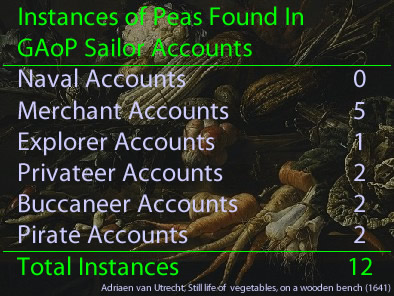
Peas
(Pisum sativum)
Called by Sailors: Peace, Peas, Pease
Vegetable Type: Legume
Appearance: 12 Times, in 10 Unique Ship Journeys from 10 Sailor Accounts.1
Locations Found in Sailor's Accounts: Cork, Ireland; Cape Cod, Massachusetts; Lagoon Dulce, Mexico; Cuba; Diafara, Panama; Chiloé Island, Chile; Puerto San Julián, Argentina; Ile Ste. Marie, Madagascar; Surat, India;
Perhaps the most notable thing about peas in the chart above is that there are none found in the naval accounts. Yet peas were the only vegetable to be including in the standard menu of the English navy. As early as 1636, the naval Victualling Contract concerning sea victuals called "for every man [to be supplied] one pound of biscuit, one gallon of beer, two pounds of beef with salt, for Sundays, Mondays, Tuesdays, and Thursdays, or instead of beef for two of those days, one pound of bacon or pork salted, and a pint of peas"2.
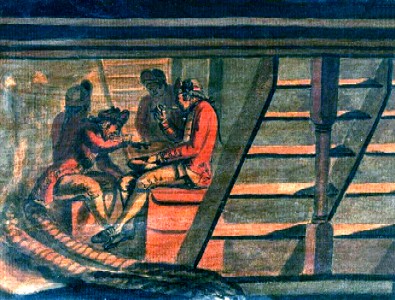
Artist: Gabriel Bray
"Four Marines Eating Pease on Board
the Pallas", National Maritime Museum, (1774)
The 1677 navy Victualling Contract refines this a bit, stating that on two days the week from those listed in 1636, sailors were to have "one pound avoirdupois of bacon, or salted English pork, of a well-fed hog not weighing less than three-quarters of a hundredweight, and a pint of pease (Winchester measure)"3. In 1701, the Admiralty repeated to the Navy Board that each sailor was to get "one pound of bacon or salted English pork, of a well fed hog weighing not less than 1 cwt., and a pint of peas, Winchester measure" twice a week.4 Swiss travel writer César De Saussure commented in 1729 that two days a week an English navy sailor, "eats boiled salted pork with a pudding of dried peas, and on the remaining two days pea soup and salt fish"5. Taken together, it is clear that peas were standard issue to the sailors of the English navy decades before the beginning of the golden age of piracy and for well afterwards. Of course, that which is common is often not mentioned, which may explain why the navy sailors do not discuss their weekly ration of peas.
Janet MacDonald says that the sort of dried pea initially used by the navy was
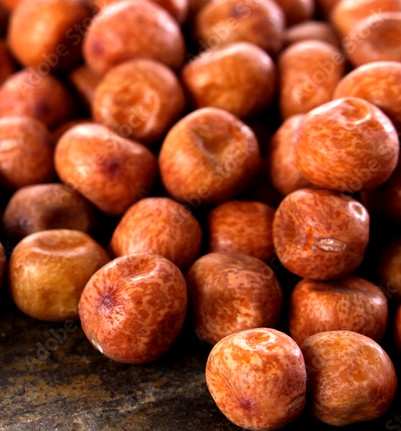
Carlin 'Pease'
"the Carlin pea (Pisum sativum s[ub]sp arvense)... a small, dark brown pea... Also known as grey peas [and black peas], these are a sub-species of the green garden pea which we mostly buy in its frozen form today (P. sativum ssp sativum)."6 Without specifying when, she says that at some point before the end of the 18th century the navy switched to the more accommodating yellow pea or split pea, which was easier to prepare. Privateer George Shelvocke is the only sailor to mention the type of pea most people think of, reporting that his men found "green peas and beans" in addition to a variety of livestock during a raid of Chiloe Island, Chile in December of 1719.7 These were almost certainly dried green peas.
During the reign of Queen Anne (1702-1714), naval peas were supplied by local English farmers, particularly in the south-east of England.8 They were were stored at Tower Hill in London, overseen by the Clerk of the Bakehouse who was "responsible for [their] receiving, issuing and packing"9. In addition, peas could be supplied via contracts made by the Victualling Commission at busy local outports such as Portsmouth.10 These were typically supplied by big London dealers who purchased their produce through local agents. "In 1703/4 there were eleven pea contractors of whom one had four contracts, one three and two others two each."11 Janet MacDonald reports that by the end of the 18th century, "pease mostly came from East Anglia [in Eastern England], either grown there or imported from the Baltic countries through the port of Yarmouth."12
Although the navy sailors accounts under study don't mention peas, they are found in the accounts of every other type of sailor, both legitimate and non. This should not be particularly surprising given that most English sailors during this period had served in the navy, either voluntarily or through impressment from merchant vessels during times of war. So they would have been accustomed to having them served at sea. Like the navy ships, the East India Company
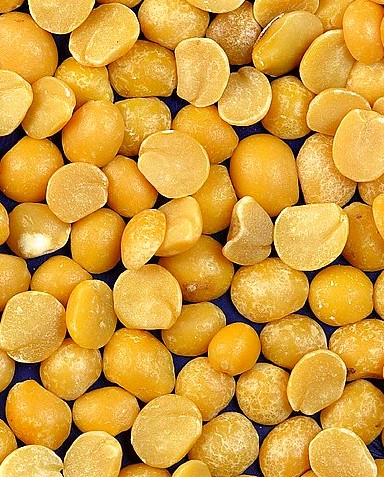
Photo: Sanjay Acharya - Yellow Split Peas
included the same sort of "staples of the crew's diet at sea [such as] dried peas and beans"13, with the beans being substituted when the supply of peas ran out. Independent merchant ships also fed them to their sailors; the captain of the merchant ship Adventure reported that before a mutiny caused by future pirate captain Joseph Bradish in 1698, "on Mondays and Fridays they had Pork and Pease" every week.14 When the merchant vessel Prince of Wales made a much longer than expected passage in 1725, Silas Told complained that they were "very short of all species of provision, expecting to have a short passage ...three days before we arrived at Blue-fields, the west end of Jamaica... [we] had been eleven weeks destitute of biscuit, pease, or flour; so that we had neither food to eat, nor water to drink."15
The records of Thomas Bowrey, a businessman who funded voyages in the late 17th and early 18th centuries, provide a window in the activities of small merchant vessels. During a business voyage made in 1698 around the Netherlands, Belgium and northern France in his Yacht Duck, Bowrey's records show he began the trip in May with a peck (2 gallons) of dried peas. At his 11th stop in Antwerp, Belgium on June 27th, he mentions purchasing pease three different times, including "Pease Beans and Cherys [cherries]", "Pease and Porter", and "Bread and Peas". In July, during his 13th stop at Ghent he purchased "Pease, Strawberrys, Cherrys" and at the 15th stop in Ostend, Belgium he bought "Smelts, Pease, Onions".16 From these descriptions, it seems likely that some, if not all, of the pease purchased in Belgium may have been fresh peas or at least reconstituted peas. However, the peck of peas purchased at the beginning of the voyage were certainly dried peas for the voyage. Bowrey's records also include those of the Mary Galley, a 167 ton vessel he organized and helped finance in 1704. These records list the victualling stores bought for a voyage to India which includes 150 bushels of peas "in tight Iron bound Cask[s]."17 Although the victualling aboard the Mary Galley when she left England was significantly more varied than most ships, the peas were the lone vegetable listed.
Buccaneer William Dampier said that while staying with the logwood cutters in 1675, he sailed a Jamaican Barque to One Bush Key (what is today Lagon Dulce, Mexico) where he "and those with me were always very kindly entertain'd by them with Pork and Pease, or Beef and Dough-Boys [dumplings]."18 When the barque was blown off course and stuck at sea, Dampier reported, "'twas by meer accident that our Food lasted so long; We boiled every day
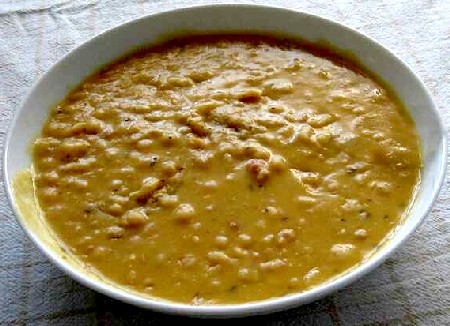
Danish Pork and Yellow Peas Soup
two pieces of [salt beef]; and because our Pease were all eaten, and our Flour almost spent, we cut our Beef in small bits after 'twas boiled, and boiled it again in Water, thickned with a little Flour, and so eat it altogether with Spoons.”19
It has already been shown that pirate Joseph Bradish inherited peas when he took the merchant ship Adventure, but there are other accounts supporting their use among pirates. Pirate Thomas Pound captured the sloop Brothers Adventure which "was loaded with the very provisions that Pound had been in search of...The loot amounted to thirty-seven barrels of pork, three of beef and a good supply of pease, Indian corn, butter and cheese."20 More telling, among the various alcohols and other items brought to Ile Ste. Marie, Madagascar in the late 17th century by Captain Jacobs which he sold to the pirates living there were "Peace [dried peas], att first [costing] 12 and afterwards 15 pc of 8 a ½ barril."21 The price increased as Jacobs ran out, indicating strong demand.
Peas in use at sea were dried and always prepared by boiling. The Carlin peas originally served in the navy can be softened "by pre-soaking them and simmering them for a long period."22 When not presoaked and/or simmered long enough, they are harder. In 1681, Robert Robertson of HMS Assistance complained that, "The peas boiled almost as hard as shot, and would by no means break."23 This suggests that the sailors during that time may have been eating Carlin peas which were not fully prepared. It is not clear when the switch was made from Carlin to yellow peas, although it appears to have been during the golden age of piracy.
The good thing for sailors about yellow peas is that cooking them is faster and easier.
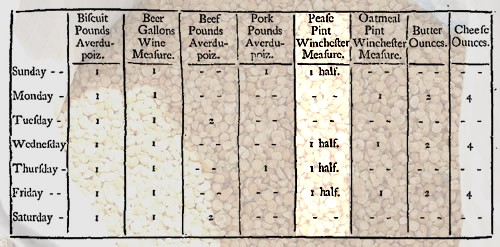
Navy Meal Plan, From Regulations and Instructions relating to His Majesty's service, 1731, p. 60
Image Photo: Derek Markwell - A Sack of Split Peas
Janet MacDonald explains that yellow peas "can be cooked in a pudding bag, in which case they will swell and form a mass which is soft enough to eat with a spoon when hot... If boiled loose in plenty of water, they will break down into an unctuous thick warming soup; this soup is traditionally enhanced by adding pieces of pork or ham."24 Recall that travel author de Saussere reported that the sailors ate salted pork made into a pudding by boiling them with dried peas. He also mentions them being served pea soup and salt fish. From this it sounds as if yellow peas may have been in use 1729. de Saussere's inclusion of soup is interesting because it was not mentioned in previous official documents as part of the standard diet. In January of 1701, the Admiralty reiterated that for two of the 'meat days' English navy sailors were to receive "one pound of bacon or salted English pork, of a well fed hog weighing not less than 1 cwt., and a pint of peas, Winchester measure."25 In December of 1703, the Victualling Board wrote the Secretary of the Navy that even when navy sailors were in port, "for two of the four days in seven whereon flesh is allowed them, they have pork with pease... no food [being] more acceptable to them"26. By 1731, however, the Regulations and Instructions relating to His Majesty's service do list 1/2 a pint of Peas being served on two of the non-meat days (see above right), which may have been where the soup that de Saussere mentioned came from.
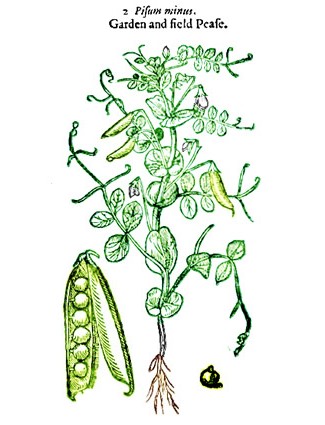
Garden Peas, From The Herball or General Historie of Plantes,
By John Gerard
(1636)
The Galenist botanists do not indicate the humoral qualities of peas. John Gerard states that peas "are in their whole substance like unto Beanes", which he said were hot and moist.27 Using the Paracelsian principles, French botanist Louis Lémery says, "They contain much Oil, essential Salt and Phlegm." He notes that they soften "the sharp Humours of the Breast" and "agree at all times... with... almost all sorts of [humoral] Constitutions, provided they be used moderately: [but] ...as for those Persons who are full of gross Humours, Pease does not agree well with them."28
Medicinally, the botanists agree that they are less 'windy' than beans, although Gerard notes that "have not a clensing faculty and therefore they do more slowly descend through the belly. They have no essentiall quality manifest, and are in a meane between those things which are of good and bad juyce, that nourish much and little"29. This he says comes from Galen. Lémery has a more positive view, indicating that peas "stop Coughing, afford good Nourishment, are mollifying [softening], and a little Laxative."30 John Parkinson has little to say about them, although he does mention that dried peas make good pottage or broth"31. He later adds that peas are "much used likewise at Sea for them that goe long voyages, and is for change, because it is fresh, a welcome diet to most persons therein."32
1 Edward Barlow, Barlow's Journal of his Life at Sea in King's Ships, East and West Indiamen & Other Merchantman From 1659 to 1703, p. 83; William Dampier, "Part 2", A Supplement to the Voyage Round the World, 1700, p. 18 & 38; Johann Dietz, Master Johann Dietz, Surgeon in the Army of the Great Elector and Barber to the Royal Court, 1923, p. 152; George Francis Dow and John Henry Edmonds, The Pirates of the New England Coast 1630-1730, 1996, p. 63; Pirates in Their Own Words, Ed Fox, ed., 2014, p. 256 & 362; Alexander Hamilton, A New Account of the East Indies, 1746, p. 144; George Shelvocke, A Voyage Round the World by Way of the Great South Sea, 1726, p. 94 & 300; Silas Told, An Account of the Life, and Dealings of God with Silas Told &c., 1786, p. 15; John Wood, "Captain Wood's Voyage Through the Streights of Magellan, &c.", A collection of original voyages, William Hacke, ed., p. 73; 2 CSP Domestic, 1636-7, 1867, p. 452; 3 J.R. Tanner, A Descriptive Catalogue of the Naval Manuscripts in the Pepsyian Library, 1903, p. 166; 4 Commander R. D. Merriman, Queen Anne's Navy, 1961, p. 254-5; 5 César De Saussure, A Foreign View of England In The Reigns Of George I and George II, Madame Van Muyden, ed., 1902, p. 363-4; 6 Janet MacDonald, Feeding Nelsons Navy, 2014, p. 33; 7 Shelvocke, p. 94; 8 John Ehrman, The Navy in the War of William III 1689-1697: Its State and Direction, 1953, p. 146; 9 Paula K. Watson, "The Commission for Victualling the Navy, the Commission for Sick and Wounded Seamen and the Prisoners of War and the Commission for Transport, 1702–1714", University of London PhD thesis, 1965, p. 83; 10 Watson, p. 88; 11 Watson, p. 88; 12 MacDonald, p. 34; 13 Jean Sutton, Lords of the East, 1981, p. 99; 14 “49. Mutiny on the Ship Adventure”, Pirates in Their Own Words, Ed Fox, ed., 2014, p. 254; 15 Silas Told, An Account of the Life and Dealings with God of Silas Told, Written by himself, 1805, p. 14-5; 16 Thomas Bowrey, The Papers of Thomas Bowrey 1669-1713, 1927, pp. 74, 80 & 81; 17 Bowrey, pp. 192 & 195; 18 Dampier, 1700, Part 2, p. 18; 19 Dampier, 1700, Part 2, p. 38; 20 Dow and Edmonds, p. 63; 21 “67. A List of the Prices that Capt. Jacobs sold Licquors and other Goods att, at St. Mary’s, 9 June, 1698. HCA 1/98, f. 142”, Pirates in Their Own Words, p. 362; 22 "Black Peas", wikipedia.com, gathered 12/5/21; 23 TNA, ADM 1/3551, fo. 79, cited in J.D. Davies, Pepys’s Navy, 2008, p. 202; 24 MacDonald, p. 34; 25 Merriman, Queen Anne's Navy, p. 254; 26 Merriman, Queen Anne's Navy, p. 268; 27 John Gerard, The Herball or General Historie of Plantes, 2nd ed, 1636, p. 1216 & 1221; 28 Louis Lémery, A treatise of foods in general, 1704, p. 59; 29 Gerard, p. 1221; 30 John Parkinson, Paradisi in Sole, Paradisus Terrestris, Reprinted from the Edition of 1629, 1904, p. 523; 31 Parkinson, p. 524
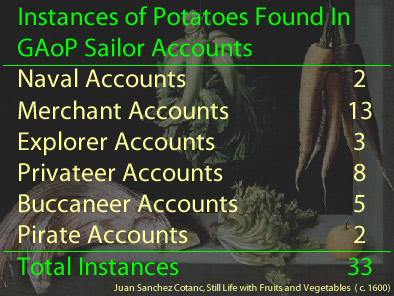
Potatoes
(Solanum tuberosum)
Called by Sailors: Potato
Vegetable Type: Root
Appearance: 33 Times, in 24 Unique Ship Journeys from 14 Sailor Accounts.1
Locations Found in Sailor's Accounts: Tenerife, Canary Islands; Cape Coast Castle, Africa; Sao Vincente, Cape Verde Islands; Sao Thome; St. Helena; Cape of Good Hope, Africa; Mauritius; Greater Tunb, Iran; Goa, Nancowry & Thalassery, India; Banda Aceh, Borneo & Pulau Buton, Indonesia; Trengannu, Malaysia; Palau Sabuda, West Papua; Batanes & Mindanao, Philippines; Haiphong, Vietnam; Guam; Marianas Islands; Ile a Vache, Haiti; Barbados; Panama; Portugal; Salvador & St Catherine's Island, Brazil; Chile;
Potatoes are the most often mentioned vegetable in the sailor's accounts under study and, unusually for this period, their name is always spelled the same way by each author. They were very familiar to Europeans so are only mentioned the sailor's texts, never described. Thomas Tryon, an outspoken vegetarian
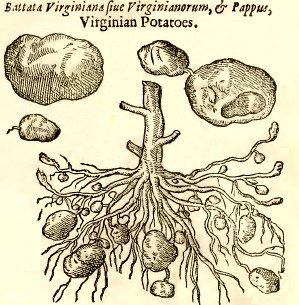
Virginian Potato, From The Herball or General Historie of
Plantes,
By John Gerard
(1636)
from the period notes that they "grow almost in the top and and surface of the Earth, are better than other Roots, and more familiar to our Natures than such as grow deeper in the Ground, because they participate more of the Influences both of the Air and Sun than the other; when they are boyl’d in good Water"2. Yet even he doesn't bother to describe them.
Two of the botanists from the decades before this period lump potatoes in with sweet potatoes. (Admittedly, they copied information from each other, so the fact that they both do so shouldn't be entirely surprising.) Writing in 1597, John Gerard referred to sweet potatoes as 'potatoes' and regular potatoes as 'Potatoes of Virginia'3. In 1629, John Parkinson referred to sweet potatoes as 'Spanish Potatoes' and, like Gerard, called regular potatoes 'Virginia potatoes'.4 Despite this, potatoes did not originally come from Virginia, they are native to southern Peru and northwestern Bolivia, being cultivated around ten thousand years ago.5 Modern food scientists Michel Pitrat and Claude Foury researched old ship's log books where they "found traces of the transport of potatoes in 1567 from the Canary Islands to Antwerp [Belgium]. Another ship, the “Trinidad”, brought them to Rouen [France] in 1574, again from the Canary Islands."6 They suggest the potato arrived in the British Isles between 1588 and 1593 and suggest Francis Drake may have brought potatoes back when returning from Virginia. This would explain why early seventeenth century botanists called them Virginia potatoes.7
By the golden age of piracy, potatoes had been widely distributed in areas where pirates roamed. Physician and former buccaneer William Hughes explains that potatoes grow "in all the Caribbee Islands that I have been in, namely, Barbados, Antego, Mevis or Nevis, S. Christophers; as also Hispaniola, Jamaica &c. where they
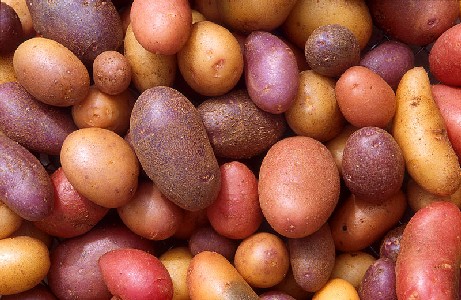
Photo: Scott Bauer, USDA Agricultural Research Services - Varieties of Potatoes
are planted in most Plantations for daily food; the small ones, or pieces, being reserv'd in digging them up, and replanted for encrease."8 Curiously, the usually encyclopedic physician/author Hans Sloane, who spent so much time in Jamaica, only writes about yams or 'Spanish potatoes' in his book.
As for the appearance of the root (which is actually different that the true potato), Parkinson says that the potato tubers "are rounder and much smaller then [sweet potatoes], and some much greater then others, dispersed under ground by many small threads or strings from the rootes, of the same light browne colour on the outside, and white within, as they, and neare of the same taste, but not altogether so pleasant."9 Gerard concurs, noting that the potato "root is thicke, fat, and tuberous, not much differing either in shape, colour, or taste, from the common [sweet] Potato's, saving that the roots hereof are not so great nor long, some of them are as round as a ball, some oval or egge-fashion, sorne longer, and others shorter; the which knobby roots are fastned unto the stalks with an infinite number of threddy strings."10
As food, French botanist Louis Lémery recommends chosing potatoes "that are large, plump, tender, reddish without, and white within, and of a good taste, like that of an Artichoak."11 Merchant and author Thomas Tryon recommends that potatoes be "eaten with Butter, Salt and Bread, they are good Food both for the Sick and the Healthy."12 Physician Hughes gives quite a bit of detail of how potatoes can be used as food:.
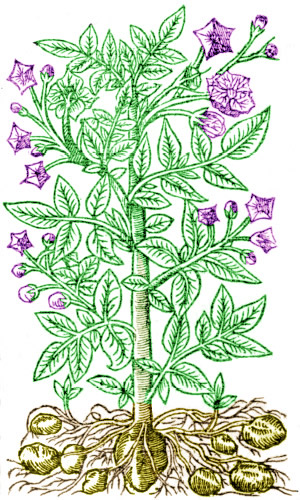
Virginia Potato Plant, From Paradisi in Sole, Paradisus
Terrestris, By John Parkinson (1629)
They are common and ordinary meat [food], used for daily food amongst all the Planters; neither are they the worse for being common: for I suppose it to be one of the best, most wholesome, and delicious Roots in the world, especially in those parts, which do much exceed Spanish Potatoes [sweet potatoes].... I have often eaten them; either roasted under the ashes, and then peeled, pulp't [mashed] and buttred, or boiled and buttred, or eaten alone, or with Girk't [pickled] Beef and Pork instead of bread: the driest of them they backe either in Pots or Pies, hardly any way comes amiss; for they are excellent food, as by experience I have often found13.
Hughes' enthusiastic support of the regular potato, is almost opposite compared to Parkinson's and Gerard's dismissive comparisons of them to sweet potatoes. (Plus he gives a recipe for mashed potatoes from the time period.)
Humorally, potatoes and sweet potatoes are the same according to Gerard. "The leaves of Potato's are hot and dry, as may evidently appeare by the taste: the roots are of a temperat qualitie."14 This suggests that the tubers don't have much impact on the bodily humors. Citing the Paracelsian principles, French botanist Lémery says, "They contain a little Salt, but much Oil, and Phlegm." He adds "They nourish the Body, moisten much, and allay the sharp humours of the Breast, [because of their 'Oily and Balsamick Principles'] but yet produce gross humours. ...They agree at all times with young bilious People, and those in general, whose humours are very sharp, and much agitated."15
Medicinally, Gerard doesn't seem to think much of the potato, only noting it as a food eaten "for pleasure, equall in goodnesse and wholesomnesse" to the sweet potato.16 Hughes has more to say, although his comments are not much different than Gerard's. He explains that potatoes "are easie of digesting, agreeing well with all bodies, especially with our hot stomacks when we come [to the Caribbean], who may at first eat of them moderately, four or five times a day, without hurt... they breed very good nourishment; they corroborate or strengthen exceeding, they chear the heart, and are provokative of bodily lust."17
1 Edward Barlow, Barlow's Journal of his Life at Sea in King's Ships, East and West Indiamen & Other Merchantman From 1659 to 1703, p. 81, 199, 239, 312, 373, 375, & 402; Edward Cooke, A Voyage to the South Sea and Round the World, Vol. 2, 1712, p. 9; William Ambrosia Cowley, "Cowley's Voyage Round the Globe", A collection of original voyages, William Hacke, ed., 1993, p. 16; William Dampier, A New Voyage Round the World, 1699, p. 12, 311, 426 & 455; Dampier, "Part 1", A Supplement to the Voyage Round the World, 1700, p. 22 & 126; Dampier, A New Voyage Round the World, Vol III, 1703, p. 10 & 72; Dampier, A Continuation of a New Voyage Round the World, Vol III, 1709, p. 98; Pirates in Their Own Words, Ed Fox, ed., 2014, p. 47, 123 & 244-5; William Funnell, A Voyage Round the World, 1969, p. 150 & 226; Alexander Hamilton, A New Account of the East Indies, 1746, p. 88, 374 & 439; Ravaneau de Lussan, The History of the Buccaneers of America, 1856, p. 329; Francis Rogers, "The Diary of Francis Rogers", Three Sea Journals of Stuart Times, 1936, p. 191; Woodes Rogers, A Cruising Voyage Round the World, 1712, p. 25 & 27; George Shelvocke, A Voyage Round the World by Way of the Great South Sea, 1726, p. 54 & 100; Nathaniel Uring, The Voyages and Travels of Captain Nathaniel Uring, 1928, p. 1067; 2 Thomas Tryon, The way to health and long life, 1697, p. 145; 3 John Gerard, The Herball or General Historie of Plantes, 2nd ed, 1636, p. 925 & 926; 4 John Parkinson, Paradisi in Sole, Paradisus Terrestris, Reprinted from the Edition of 1629, 1904, p. 516; 5 "History of the Potato", wikipedia.com, gathered 12/14/22; 6 Michel Pitrat & Claude Foury, Histoires de légumes, 2015, translated by the author, pp. 398-399; 7 Pitrat & Foury, p. 401; 8 William Hughes, The American physitian, 1672, p. 13; 9 Parkinson, p. 516; 10 Gerard, p. 927; 11 Louis Lémery, A treatise of foods in general, 1704, p. 99; 12 Thomas Tryon, The way to health and long life, 1697, p. 146; 12 Hughes, pp. 14-5; 14 Gerard, p. 926; 15 Lémery, p. 99; 16 Gerard, p. 928; 17 Hughes, p. 14;
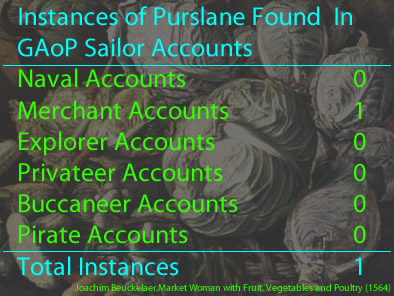
Purslane
(Portulaca oleracea)
Called by Sailors: Purslain
Vegetable Type: Salading
Appearance: 1 Time, in 1 Unique Ship Journey from 1 Sailor Account.1
Locations Found in Sailor's Accounts: Haiphong, Vietnam;
Purslane only appears in one of buccaneer William Dampier's accounts. His description of that which he found in Tonquin (modern Haiphong, Vietnam) while sailing with Captain Weldon on the East Indiaman Curtane, both disparages and compliments it. "The Land is every where cloathed with herbage of one kind or other, but the dry Land has the same Fate that most dry Lands have between the Tropicks, to be over-run with Purslain which growing wild, and being pernicious to other tender Herbs and Plants, they are at the pains to weed it out of their Fields and Gardens, tho 'tis very sweet, and makes a good Sallad for a hot Country."2
The origin of purslane is uncertain, likely because it was spread by humans
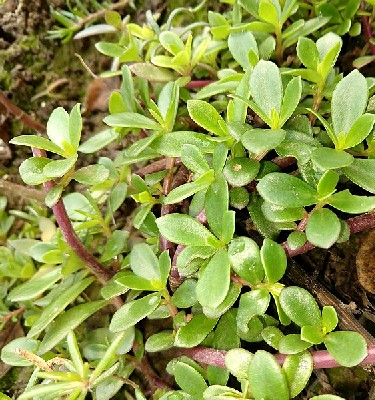
Common Purslane in India
and is currently found all over the world, growing on beaches. It is found in southern Europe, northern Africa, the Indian subcontinent, the Middle East and Australia. There is some suggestion that it my have reached the Americas before Columbus3, although the only mention of it by period sailors is in the Far East. None of the physicians books used here which focus on flora in the New World mention it. Most of the herbals which focus on flora in Europe discuss it, suggesting it was uncommon in the Americas at this time.
French botanist Louis Lémery indicates that there are two types of purslane: wild and garden. He suggests the only difference between them is that the wild purslane had smaller leaves.4 Botanist John Parkinson describes purslane as having "many thicke round shining red stalkes, full of juice, lying upon the ground for the most part; whereon are set divers long, thicke, pale green leaves, sometimes alone by themselves, and sometimes many small ones together with them"5. Fellow botanist John Gerard notes that "the leaves be an inch long, something broad, thicke, fat, glib, somewhat greene, whiter on the nether side: the floures are little, of a faint yellow, and grow out at the bottome of the Ieaves. After them springeth up a little huske of a greene colour, of the bignesse almost of halfe a barly corn, in which is small blacke seed"6.
Of purslane's flavor, Parkinson says that garden variety "hath little or no taste but [a] waterish or herby [flavor]."
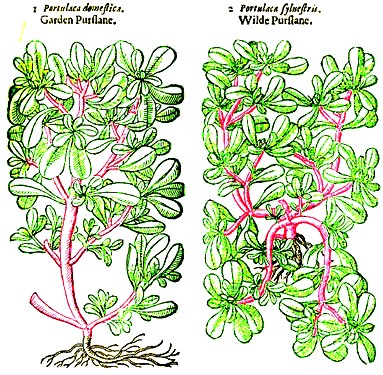
Garden and Wilde Purslain, From The Herball or General Historie of
Plantes, By John Gerard (1636)
He adds wild purslane "is somewhat more astringent in taste (as for the most part all wilde herbes are)"7. Beyond these comments, we only have Dampier's comment that it is 'very sweet.
As food, Lémery recommends chosing "young, tender, and juicy Purslain [leaves]."8 He adds that it "is much used in Food. They put it into cooling Broths and Sallets. Some there are who preserve them with Vinegar and Salt."9 In salads, Gerard recommends that the leaves be dressed "with oyle, salt and vinegre"10, as was common during this period. He adds that it can be eaten raw or boiled. Parkinson simply states that the leaves are used in the same way lettuce is in salads.11 Author, gardener and Commissioner of the Navy's Sick and Hurt Commissions (second and third) John Evelyn recommended that purslane be "mingled with the hotter Herbs"12. He adds that some people enjoy it pickled, which makes it easier on the stomach. "Some eat it cold, after it has been boil'd, which Dr. [Thomas] Muffet would have in Wine, for Nourishment."13
Regarding Purslane's humoral properties, Parkinson cites Galen of Pergamon: "Garden Purslane is cold in the third degree, and moist in the second ...& is therefore good to coole any heate in the liver, bloud, reines [kidneys] and stomack"14. Gerard also recites Galen's assessment, adding that "wilde Purslane is not so moist."15 Lémery takes exception to this, opining "that these two Kinds are like enough to one another in their Effects." From the Paracelsian perspective, Lémery says the humoral principles include "much Oil and Phlegm, but a little Salt." He adds that it "is of a moistning and cooling Nature, by reason of its bilious and phlegrnatick Juice, which is proper to embarass and diffuse the sharp Salts."16
Medicinally, Gerard has much to say. Purslane leaves are
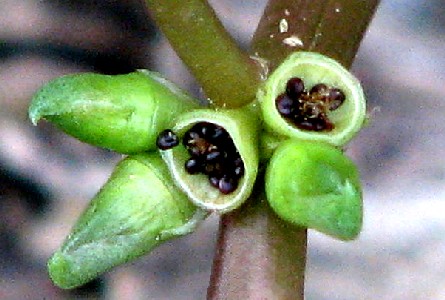
Photo: wiki user Happiness - Purslane Seed Pods
good for the bladder and kidnies, and allaieth the outragious lust of the body: the juyce also hath the same vertue.
The juyce of Purslane stoppeth the bloudy flix [flux], the flux of the hemorrhoides, monethly termes, spitting of bloud, and all other fluxes whatsoever.
The same throwne up with a mother syringe, cureth the inflammations, frettings and ulcerations of the matrix [womb]; and put into the fundament [anus] with a clister pipe [clyster or enema syringe], helpeth the ulcerations and flux [flow] of the guts.
The leaves eaten raw, take away the paine of the teeth, and fasten them and are good for teeth that are set on edge, with eating of sharpe or sowre things.
The seed being taken, killeth and driveth forth wormes, and stoppeth the laske [looseness of the bowels.17
Purslane seeds (called semen portaluca) were included in some of the sea surgeon's medicine chests from this period. Parkinson says, "The seede of Purslane doth coole much any inflammation inward or outward, and doth a little binde withall."18 In his second book, he repeats much of what Gerard says, adding that it stopped "the whites [discharges from the vagina] & gonorrhea the distillations from the head & the paines therein proceeding of heate, want of sleepe, or the Frenzie"19. Evelyn adds an interesting counterpoint to all this love for the plant: "Purslain is accus'd for being hurtful to the Teeth, if too much eaten."20 Gerard and Parkinson both recommended purslane for reducing the pain in teeth, making this comment rather curious.
1,2 William Dampier, "Part 1", A Supplement to the Voyage Round the World, 1700, p. 22; 3 "Portulaca oleracea", wikidpedia.com, gathered 12/15/22; 4 Louis Lémery, A treatise of foods in general, 1704, p. 91; 5 John Parkinson, Paradisi in Sole, Paradisus Terrestris, Reprinted from the Edition of 1629, 1904, p. 499; 6 John Gerard, The Herball or General Historie of Plantes, 2nd ed, 1636, p. 521; 7 John Parkinson, Theatrum Botanicum the Theater of Plants, 1640, p. 722; 8 Lémery, p. 91; 9 Lémery, p. 92; 10 Gerard, p. 522; 11 Parkinson, Paradisi in Sole..., p. 499; 12 John Evelyn, Acetaria, or a Discourse of Sallets, 1699, p. 55; 13 Evelyn, p. 56; 14 Parkinson, Theatrum Botanicum..., p. 723; 15 Gerard, p. 522; 16 Lémery, p. 92; 17 Gerard, p. 522; 18 Parkinson, Paradisi in Sole..., p. 499; 19 Parkinson, Theatrum Botanicum..., p. 723; 20 Evelyn, p. 56
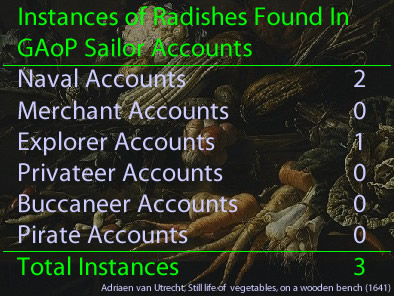
Radish
(Raphanus raphanistrum subsp. sativus)
Called by Sailors: Radish, Reddish
Vegetable Type: Root
Appearance: 3 Times, in 3 Unique Ship Journeys from 3 Sailor Accounts.1
Locations Found in Sailor's Accounts: Spain; Malta; Puerto San Julián, Argentina;
Radishes were quite familiar to English sailors so they are only included of lists of foods found during landfall. Botanists have determined that all species of radish are an old world root, originating in the Mediterranean, having been cultivated from wild radishes.2 "[S]cientists have tentatively located the origin of Raphanus sativus in Southeast Asia, as this is the only region where truly wild forms have been discovered."3 This doesn't mean there weren't any in the New World by the golden age of piracy; they are one of the vegetables planted there by arriving Europeans. "The radish was one of the first vegetables introduced into the New World. Radishes were already under cultivation in Mexico in 1500 and in Haiti in 1565."4 During the GAoP, they were found on several English provisioning islands in the Caribbean including Barbados, Juan Fernandez and Jamaica.
Botanist John Gerard gives a good assessment of the variety of radishes.
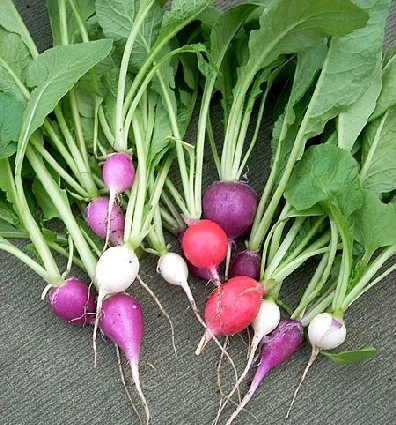
Photo: wiki user Jengod - A Variety of Colors of Garden Radishes
"There be sundry sorts of Radish, whereof some be long and white (possibly Daikon radishes - Raphanus sativus var. longipinnatus), others long and black (black radish - Raphanus sativus var. niger); some round and white, others round or of the form of a peare, and blacke of colour (probably Raphanus raphanistrum subsp. sativus); some wild or of the field (Raphanus sativus var. raphanistroides), and same tame or of the garden (Raphanus raphanistrum subsp. sativus)"5. Fellow botanist John Parkinson notes that the garden radish "is long, white, and of a reddish purple colour on the outside toward the toppe of it"6 while the black radish "is blackish on the outside ...and white within, great and round at the head, almost like a Turnep, but ending shorter then a Raddish, and longer then a Tumep, almost peare-fashion, of a firmer and harder substance then the ordinary Raddish"7. Gerard suggests that the best is the round radish which "is round and firme, nothing waterish like the common Radish" and the pear-shaped radish "is fashioned like a Peare or long Turnep,
black without, and white within, of a firme and solid substance."8
Regarding the flavor, everyone agrees that most of them are tart. Gerard says his 'long and white' radish is "of a sharp taste"
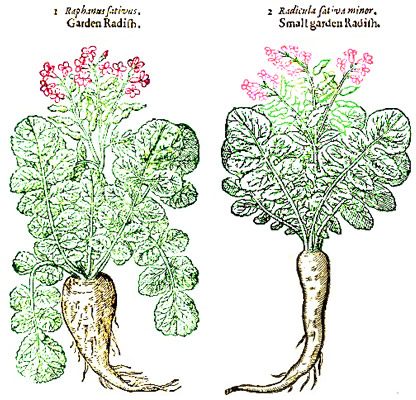
Garden Radishes, From The Herball or General Historie of
Plantes,
By John Gerard (1636)
and the pear-shaped radishes "tast is quick and sharp, biting
the tongue as the other kinds of Radish, but more strongly." He mentions one exception, the round radish, which is "more pleasant in tast,
wholsomer, not causing such stinking belchings as the garden radish doth."9 Parkinson simply notes that garden radishes are sharp and biting, highlighting black radishes which he says are "somewhat strong withall"10.
In picking radishes to eat, French botanist Louis Lémery advises "those that are tender, Juicy, of a sharp and pungent taste, but pleasant, easie to be broken, and not very thick." He adds, "All the parts of a Radish may be wholsom, however, there is none of it used for Food but the root, they pull it out of the Earth, especially in the Spring."11 In his discourse on salads John Evelyn says that the roots "provide a very greatful mordacity [biting flavor], and sufficiently attempers the cooler Ingredients." He suggests that the best radishes are "transparent, eat short and quick, without stringiness, and not too biting. These are eaten alone with Salt only, as carrying their Peper in them and were indeed by Dioscorides and Pliny celebrated above all Roots whatsoever"12.
Gerard has a poor opinion of radishes as food, explaining, "Radish are eaten raw with bread instead of other food; but in that manner they yeeld very little
nourishment and that faulty and il. But for the most part they are used as sauce with meats to procure appetite"13. This idea of a radish being a 'sauce' sounds odd today. Samuel Johnson defined sauce in 1756 as "Something eaten with food to improve its taste."14 So sauce here doesn't mean a thick liquid, it refers to how it affects the flavor when eaten with other food.
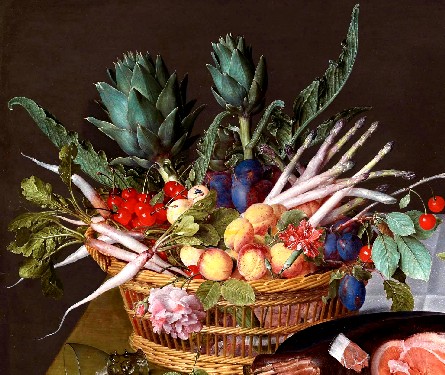
Artist: Jacob van Hulsdonck
Radishes (at left) From Detail of Still Life with Fruit and Vegetables in a Basket (c. 1615)
Botanist Parkinson concurs with Gerard adding that it is the poor who eat them with bread, but does so without opining on their usefulness as food. He notes that black radishes are regarded in the low countries (which today include Belgium, Netherlands and Luxembourg) as "a rare winter sallet"15.
Humorally, Gerard explains, "Radish doth manifestly heat and dry, open and make thin by reason of the biting qualitie that ruleth in it. Galen makes them hot in the third degree, and dry in the second, and showeth that it is rather a sauce than a nourishment."(This further clarifies his reference to radishes as a sauce.) He later says that when they accompany other food, "they ingender less bad bloud [one of the four bodily humors], than [when] eaten alone or with bread only"16. Striking the Paracelsian note, Lémery says a radish "contains a little Oil, and much essential Salt, arid Phlegm. It agrees in cold weather with Phlegmatick [those having an excess of wet and cold humors] and Melancholy [those with an excess of cold and dry humors] People, provided they have a good Stomach." He also suggests that the sharp flavor comes from "its essential Salts, which are very incisive, penetrating, and a little confined and embarassed by the Oily parts."17
John Evelyn suggests that the radish is "rather Medicinal" before going on to explain how well they go with salads. He also notes that revered classical physicians Galen and Dioscoredes "differ about their Eating", which helps explain why Gerard's assessment of their use as food disagrees with the other authors.
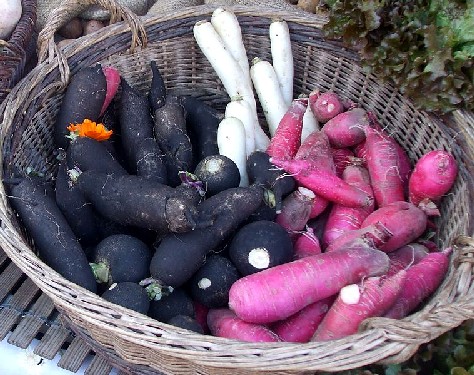
Photo: wiki user Le grand Cricri - Black, White and Red Radishes in a Basket
He adds, "the great Hippocrates utterly condemns them... [as] hard of Digestion, Inimicous [an enemy] to the Stomach, causing nauseous Eructations [belching], and sometimes Vomiting, tho' otherwise Diuretic [producing urine], and thought to repel the Vapours of Wine, when the Wits were at their genial Club."18 Gerard recommends that they be eaten with food rather than before [which comes from Galen]; otherwise they "cause belchings and overthrow the stomacke." He says they "provoketh urine, and dissolveth cluttered sand [calcium, the source of kidney stones], driving it forth" leading him to suggest they be combined with honey and vinegar [Oximel] and drunk in the morning.19
Parkinson, on the other had, takes Dioscoredes advice to heart and recommends radishes "as a stlimulum before meat, giving an appetite thereunto". He again endorses black radishes for their use "in medicines that helpe to breake the stone [calcium accretions], and to avoyde grauell [in the kidneys]."20 Lémery likewise recommends them for this, adding that they "are good for the Cholick in the Back [lower back pain], they help Women's Months, and create an Appetite. They make use of them for the Spleen and Messentery [a fold of tissue that attaches organs to the body wall], for the Jaundice and Dropsie. They are of a detersive [cleansing] and cutting nature; they are bruised and applied to the Soles of the Feet in malignant Feavers."21
1 Edward Barlow, Barlow's Journal of his Life at Sea in King's Ships, East and West Indiamen & Other Merchantman From 1659 to 1703, p. 69; Henry Teonge, The Diary of Hentry Teonge, 1825, p. 133; John Wood, "Captain Wood's Voyage Through the Streights of Magellan, &c.", A collection of original voyages, William Hacke, ed., p. 73; 2 Michel Pitrat & Claude Foury, Histoires de légumes, 2015, translated by the author, pp. 364; 3 "Radish", wikipedia.com, gathered 12/16/22; 4 "The Radish – A Little History and Some Growing Instructions", havesting-history.com, gathered 12/16/22; 5 John Gerard, The Herball or General Historie of Plantes, 2nd ed, 1636, p. 84; 6 John Parkinson, Paradisi in Sole, Paradisus Terrestris, Reprinted from the Edition of 1629, 1904, p. 509; 7 Parkinson, Paradisi in Sole..., p. 510; 8,9 Gerard, p. 238; 10 Parkinson, Paradisi in Sole..., p. 510; 11 Louis Lémery, A treatise of foods in general, 1704, p. 104; 12 John Evelyn, Acetaria, or a Discourse of Sallets, 1699, p. 57; 13 Gerard, p. 238; 14 Samuel Johnson, A dictionary of the English language 2nd part, 1756, not paginated; 15 Parkinson, Paradisi in Sole..., p. 510; 16 Gerard, p. 239; 17 Lémery, p. 104; 18 Evelyn, p. 57-8; 19 Gerard, p. 239; 20 Parkinson, Paradisi in Sole..., p. 510; 21 Lémery, p. 104
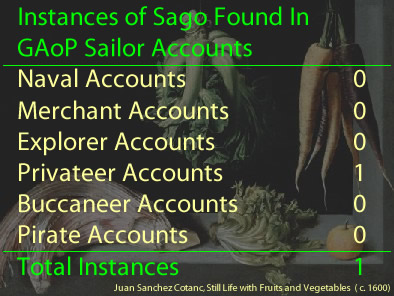
Sago
(Metroxylon sagu)
Called by Sailors: Sago
Vegetable Type: Other (starch)
Appearance: 1 Time, in 1 Unique Ship Journey from 1 Sailor Account.1
Locations Found in Sailor's Accounts: Mindanao, Philippines;
Sago is similar to cassava in that it is an edible starch usually obtained from palm plants, processed into something like flour and used to make bread. It is not a grain, so it is included here as plant matter. William Dampier describes it in his account of the Philippines when the buccaneer ship Cygnet was there in 1686. His is the sole sailor's account of this interesting vegetable starch, however, probably because his is one of the few accounts from the period describing this area.
Sago appears in botanist John Parkinson's Theatrum botanicum, referred to there as "Arbor Farinfer, The Bread tree"2. The relevant parts of the description (which are limited) are a translation of information that found in the 1582 book Aliquot notae in Garciae Aromatum historiam (Some notes on the history of the Garcia Spices) attributed to physician and botanist Carolus Clusius. However, German botanist Georg Eberhard Rumphius, who wrote about the
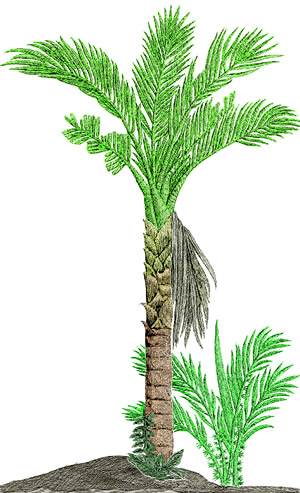
Artist: Georg Eberhard Rumphius
Sagu Palm, The Ambonese Herbal (1741)
flora of Indonesia where sago is widely used, is really the only botanical author to provide much detail about it. He suggests there are four different types of sagu palm, "all of which resemble each other a great deal, so that the difference is mostly evident in their thorns [found on the trunk] and fruits."3 Since all of them produce the same pithy starch, those interested in his descriptions are referred to his text.
Rumphius notes that the tree can produce fruit, "but they are seldom seen because the natives do not wait that long, because this tree will lose its greatest attribute when it bears fruit, and that is being able to make meal [from sago starch] from it, because the inner marrow will by then have changed into coarse threads."4 The editor of the English edition of his book says that there are "various Palm Trees that supply meal and bread, but none, to my knowledge, that provide such an abundance of good meal as the Sagu, as described by Rumphius"5. Rumphius himself doesn't go into detail about the the processing or use of the starch obtained from the tree.
Fortunately, Dampier's report of finding it in Mindanao, Philippines in 1686 and the description of how the pith of the sagu palm was processed to produce sago starch is fairly thorough.
There is one sort [of tree] which deserves particular notice [on Mindanao]; called by the Natives Libby-Trees [Metroxylon sagu]. These grow wild in great Groves of 5 or 6 Miles long, by the sides of Rivers. Of these Trees Sago is made, which the poor Country People eat instead of Bread 3 or 4 Months in the Year. This Tree for its body and shape is much like the Palmeto-Tree, or the Cabbage-Tree [which produces Heart of Palm], but not so tall as the latter. The Bark and Wood is hard and thin like a Shell and full of white Pith, like the Pith of an Elder. This Tree they cut down, and split it in the middle and scrape out all the Pith; which they beat lustily with a Wooden Pestle in a great Mortar or Trough, and then put it into a Cloth or Strainer held over a Trough; and pouring Water in among the Pith, they stir it about in the Cloth: So the Water carries all the Substance of the Pith through the Cloth down into the Trough, leaving nothing in the Cloth but a light sort of Husk, which they throw away; but that which falls into the Trough settles in a short time to the bottom like Mud; and then they draw off the Water, and take up the muddy Substance, wherewith they make Cakes4
This is similar in some ways to the processing of cassava starch, although the starch is does not need to have a toxic element removed like cassava and it is retrieved from the pith of the plant rather than the root.
As food, "sago is prepared by pouring a little amount of hot water into starch and stirring properly until it becomes sticky dough."7 Dampier mentions that
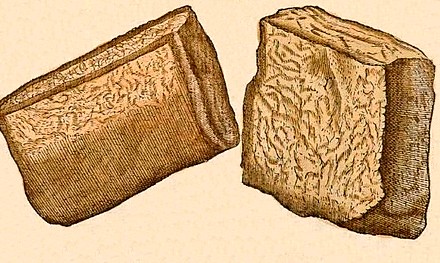
Sago Cakes, From Aliquot notae in Garciae Aromatum historiam, Att. Carolus Clusius (1582)
once the starch is obtained, "being bak’d proves very good Bread."8 Carolus Clusius says the starch can be made into "breads or cakes, sometimes palm-sized, of the thickness of an ounce, which the inhabitants of those islands eat when they are cold and freshly cooked"9. A variety of other traditional uses of sago include roasting the pith after harvesting, processing into a paste which can be molded into bread, biscuit or noodles and drying the paste to produces a sort of flour for later use.
Although it is likely that Dampier saw sago being processed, it is not clear from his description that he every tasted it. According to Clusius, "When I tasted it, it seemed to me that this bread had an insipid taste: but if it is sprinkled with a bit of pepper, cinnamon or sugar, some may find it delicious."10
Neither physician Clusius nor botanist Parkinson talk about the medicinal properties of the starch obtained from the sagu palm. Rumphius' description focuses on describing the plant, not its uses.
1 William Dampier, A New Voyage Round the World, 1699, p. 310; 2 John Parkinson, Theatrum Botanicum the Theater of Plants, 1640, p. 1646; 3 Georgius Everhardus Rumphius, The Ambonese Herbal, E. M. Beekman, Ed, Vol. 1, 2011, p. 296; 4 Rumphius, Vol. 1, p. 294; 5 Rumphius, Vol. 1, p. 300; 6 Dampier, 1699, p. 310-1; 7 Andi Patiware Metaragakusuma, Osozawa Katsuya and Hu Bai "An Overview of The Traditional Use of Sago for Sago-based Food Industry in Indonesia", International Conference on Agro-Industry, 2015, p.120; 8 Dampier, 1699, p. 311; 9,10 Carolus Clusius (att), Aliquot notae in Garciae Aromatum historiam, 1582, p. 24
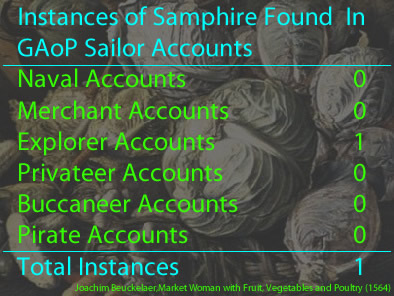
Samphire
(Limbarda crithmoides)
Called by Sailors: Sampier
Vegetable Type: Salading
Appearance: 1 Time, in 1 Unique Ship Journey from 1 Sailor Account.1
Locations Found in Sailor's Accounts: Timor, Indonesia;
Samphire is one of several vegetables mentioned only by William Dampier. He mentions finding it on Timor Island during his exploratory voyage to Australia. He does not bother to describe it, probably because it was quite familiar to the English, even being mentioned by Shakespeare.2
The term samphire encompasses a wide variety of salt-tolerant, succulent plants which typically grow near water. Botanist John Gerard discusses three different types: "Rocke Sampier",
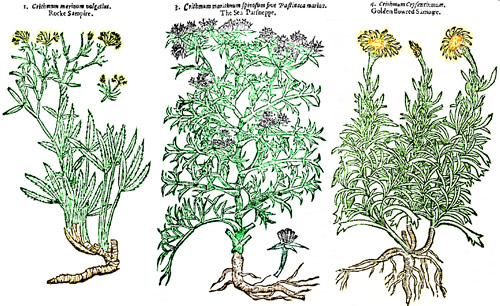
The Three Types of Samphire Plants, From Theatrum Botanicum the Theater of Plants,
By John Parkinson (1640)
"Pastinaca marina, or sea Parsnep", and "Golden Sampier". He notes that all three grow in England.3 Botanist John Parkinson describes four types of samphire, including all of those Gerard describes, but he further divides Rock Samphire into regular and greater varieties.4 All of the names mentioned by the period botanists are still in use today; both Rock Samphire (Crithmum maritimum) and sea parsnips (Echinophora spinosa) are found primarily in the Europe. Golden samphire (Limbarda crithmoides) is widely distributed throughout Eurasia5, making it the most likely candidate for what Dampier saw on Timor Island and was familiar with.
Parkinson describes the golden samphire as having "sundry round stalkes, rising from the roote, thickely stored with very narrow long and somewhat thicke leaves cut in at the endes: at the toppes of the stalkes stand single flowers... wholly yellow, both the border and thrumme in the middle, where lye the seed when they are ripe"6. He also adds that they grow close to sea shores. Gerard says they are "compassed about with a multitude of long fat leaves, set together by equal distances"7.
As food, physician John Pechey notes that they are "saltish" and the roots are "of a sweet, acrid and Aromatick Taste."8 Parkinson says samphire is "very pleasant both to the taste and stomacke, not only by its saltnesse,
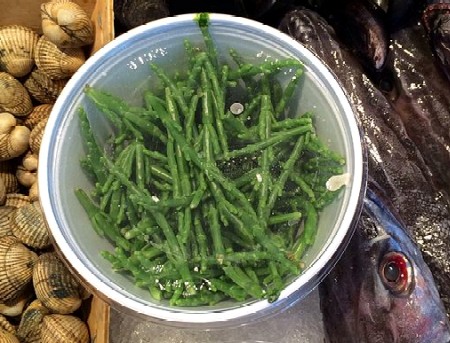
Photo: Wiki user Vouliagmeni - Fresh Samphire For Sale at a Market
but by the spicinesse"9. Gardener and author John Evelyn writes that "when young and tender (and such as we may Cultivate, and have in our Kitchin-Gardens, almost the Year round) is in my Opinion, for its Aromatic, and other excellent Vertues... so far perferrable to most of our hotter Herbs"10.
In regard to preparation, Pechey says, "Sampire pickled is very palatable, and agreeable to the Stomach."11 Evelyn calls it one of the better "Sallet-Ingredients". He goes on to talk about a French variation which he warns "does not indeed Pickle so well, as being of a more tender Stalk and Leaf: But in all other respects for composing Sallets, it has nothing like it."12 Along similar lines, Gerard suggests if "kept in pickle, and eaten in sallads with oile and vineger, is pleasant sauce for meat [food]"13. Parkinson suggests boiling samphire roots and leaves in wine (although primarily for medicinal use), adding that "it is eaten both raw and boyled as other herbes and pickled up to be kept"14.
Drawing upon information from Galen, Gerard says that humorally, "Sampier doth dry, warm,and scoure"15. Parkinson believes this is because of its saltiness and bitterness, "whereby it hath a effectual property to dry and cleanse, but yet each of these properties are weaker in it, then it is in those things which are bitter."16 Evelyn says it has "excellent Vertues and Effects against the Spleen, Cleansing the Passages"17. The spleen was thought to produce one of the bodily humors, yellow bile. Gerard expanded samphire's cleansing facility to include the "liver, milt [spleen], kidnies and bladder"18.
Medicinally, it was felt by most period authors to produce urine. Building upon Gerard's comment, Parkinson says it is useful for "opening in some sort the obstructions of the liver and spleene, provoking urine and helping thereby to wash away the gravell and stone engendred in the kidneys or bladder"19.
1 William Dampier, A Continuation of a New Voyage Round the World, Vol III, 1709, p. 73; 2 "Half-way down Hangs one that gathers samphire; dreadful trade!", William Shakepeare, King Lear, Act IV, Scene VI, Lines 14-15; 3 John Gerard, The Herball or General Historie of Plantes, 2nd ed, 1636, p. 533; 4 Parkinson, Theatrum Botanicum the Theater of Plants, 1640, p. 1286-7; 5 See the entries Echinophora spinosa and Samphire, wikipedia, gathered 12/31/22; 6 Parkinson, p. 1287; 7 Gerard, p. 533; 8 John Pechey, the compleat herbal, 1707, p. 208; 9 Parkinson, p. 1287; 10 John Evelyn, Acetaria, or a Discourse of Sallets, 1699, p. 62; 11 Pechey, p. 208; 12 Evelyn, p. 62; 13 Gerard, p. 534; 14 Parkinson, p. 1287; 15 Gerard, p. 534; 16 Parkinson, p. 1287; 17 Evelyn, p. 62; 18 Gerard, p. 534; 19 Parkinson, p. 1287-8
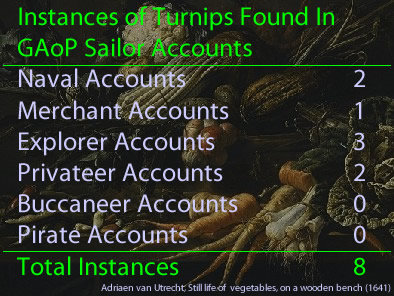
Turnips & Greens
(Brassica rapa subsp. rapa)
Called by Sailors: Turnip, Spelman's Neap
Vegetable Type: Root & Salading
Appearance: 8 Times, in 8 Unique Ship Journeys from 7 Sailor Accounts.1
Locations Found in Sailor's Accounts: Thames, England; Messina, Italy; Tenerife, Canary Islands; Cape of Good Hope, Africa; Jakarta, Indonesia; Salvador, Brazil; Juan Fernandez Island, Chile; Puerto San Julián, Argentina;
Turnips are mentioned several times in sailor's accounts, being issued by the navy as a 'fresh food' by the navy before the beginning of the golden age of piracy. Historian N. A. M. Rodger says this occurred after Samuel Pepys' attempt to reform the pursery in the later half of the seventeenth century. In 1672, Rear Admiral John Narborough was lying at the Nore - a sandbank at the mouth of the Thames - where he described a delivery of fresh food for the sailors waiting shipboard. "This day fresh meat
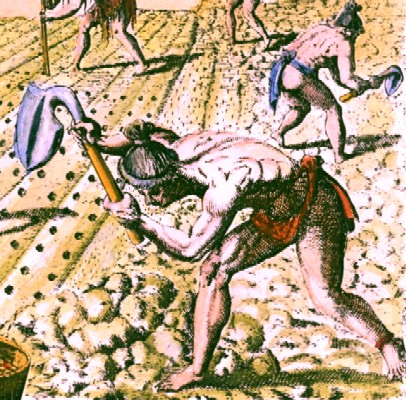
Artist: Theodor de Bry
Timucua Natives Planting, From Brevis narratio eorvm qvæ in Florida Americæ, (1591)
came down for the whole fleet and a vessel laden with 3950 cabbages and 211 bushels of carrots and 15 dozen and 9 bunches of turnips, for to be disposed of for the use of the fleet in the several ships for refreshing of the men."2 Curiously, he goes on to detail how the cabbages and carrots were distributed, but not the much lesser numbers of turnips. Navy clerk John Baltharpe was aboard HMS St. David when she stopped at Messina, Italy in November of 1670, where he mentions them being offered for sale to the sailors while in port. This was for individual purchase, however; there is no indication that the navy purchased them for the men here.3
The navy is not alone in the use of turnips as food while abroad. Woodes Rogers mentioned finding "store of turnip greens" on Juan Fernandez island when his privateer fleet stopped there in February of 1709. He explains, "the Turnips, Mr. [Alexander] Selkirk told us, are good in our Summer Months, which is Winter here; but this being Autumn, they are all run to seed, so that we can’t have the benefit of any thing but the Greens."4 Explorer John Wood's ships Sweepstakes and Batchellor Pink actually planted turnips, along with beans, peas and radishes in what is today Puerto San Julian, Argentina in 1670. Returning later, he reported that "The Turnips were very good, but for the Reddishes, Beans and Pease, they were gone to Seeds; Neither could we perceive that the Indians had used any of them, but only pulled them up by the Roots, and then left them to wither."5
Turnips likely came from the Mediterranean region although when they were first planted as food is not clear. "The cultivation of turnips as an edible crop predates recorded history, but is likely to have originated in northern Europe, between the Baltic and the Caucasus. Turnips were an important food for the Romans, and by the classical period, many varieties were available.. The earliest archaeological record of turnip root is from the 13th century Byzantine Sparta, Greece."6
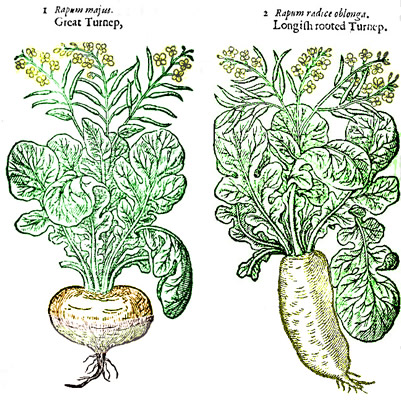
Great and Long Turnips, From The Herball or General Historie of
Plantes,
By John Gerard (1636)
Turnips take various forms. Botanist John Gerard says there are "sundry sorts of Turneps, some wild, some of the garden; some with round roots globe fashion, other ovall or peare-fashion; and another sort longish or somewhat like a Radish: and of all these there are sundry varieties, some being great and sorne of a smaller sort."7 Fellow botanist John Parkinson agrees, chosing to identify them by the color of their roots "as white, yellow, and red: the white are the most common, and they are of two kinds, the one much sweeter then the other. The yellow and the red are more rare, and noursed up only by those that are curious"8.
Taking a different tack, French botanist Lewis Lémery states that there are two types, "the Male and Female, the last of which is much more esteemed than the other."9 This is not accurate, although he does at least explain that they "do not differ much from one another, only the Male is usually round, about the bigness of a Child's Head, and much extended in breadth; and that the Female is oblong: Both the one and the other sometimes grow to a prodigious bigness."10
Parkinson gives a detailed description of all of the different types of turnips he mentions.
Photo: Muhammad Irshad Ansari - Red Turnips
The ordinary Garden Turnep hath many large, and long rough greene leaves with deepe and uneven gashes on both sides of them: the stalke riseth up among the leaves about two foote high, spread at the toppe into many branches, bearing thereon yellow flowers, which turne into long pods, with blackish round seede in them: the roote is round and white, some greater, some smaller; the best kinde is knowne to be flat, with a small pigges tale-like roote underneath it; the worser kinde which is more common in many places of this land, both North and West, is round, and not flat, with a greater pigges tayle-like roote underneath.
The yellow kinde doth often grow very great, it is hardly discerned from the ordinary kinde while it groweth, but by the greatnesse and spreading of the leaves beeing boyled, the roote changeth more yellow, somewhat neare the colour of a Carrot.
The red Turnep groweth usually greater then any of the other, especially in a good ground, being of a faire red colour on the outside, but being pared, as white as any other on the inside.11
When selecting turnips to eat, Lémery recommends chosing "such as are tender, plump, of a good Taste, and that grow in a fat and moist Soil."12 Author John Evelyn suggests "with us, the yellow is preferr'd; by others the red Bohemian."13 Parkinson says that "all of them eate most kindly, and by reason of their sweetnesse are much esteemed"14. Merchant and professed vegetarian Thomas Tryon advised that "Turnips are a Root of a very innocent and mild Nature"15. He goes on to say that because turnips "grow almost in the top and and surface of the Earth, [they] are better than other Roots, and more familiar to our Natures than such as grow deeper in the Ground, because they participate more of the Influences both of the Air and Sun than the other"16.
Regarding their preparation, Gerard says turnips are "many times eaten raw, especially of the poore people in Wales,
Photo: Yercaud Elango - Sliced Turnip
but most commonly boiled." He goes on to warn, "It availeth not a little after what maner it is prepared; for being boiled in water, or in a certain broth, it is more moist,and sooner descendeth" in the digestive system.17 According to Parkinson, they are good "boyled in salt broth... and [are] often seene as a dish at good mens tables: but the greater quantitie of them are spent at poore mens feasts."18 Tryon advises "when they are boyl’d in good Water,
And eaten with Butter, Salt and Bread, they are good Food both for the Sick and the Healthy."19 John Evelyn says, "Some roast Turneps in a Paper under the Embers, and eat them with Sugar and Butter."
However, Evelyn mentions a more novel use for turnips than the other authors under study. He provides a recipe for an "agreeable sort of Bread, we are taught to make" by Roman naturalist Pliny in his Philosophical Transactions. "Let the Turneps first be peel'd, and boil'd in Water till soft and tender; then strongly presting out the Juice, mix them together, and when dry (beaten or pounded very fine) with their weight of Wheat-Meal, season it as you do other Bread, and knead it up; then letting the Dough remain a little to ferment, fashion the Paste into Loaves, and bake it like common Bread."20
The botanical authors are a little vague on the humoral qualities of turnips. The usually reliable Gerard rather provides a rather circumspect explanation. "The raw root is windy, and engendreth grosse and cold bloud: the boiled doth cool lesse, and so little, that it cannot be perceived to coole at all, yet is it moist and windy."21 From this, it appears that turnips are moist and somewhat cooling, but only when raw. Evelyn, on the other hand, reports that it is moderately hot and moist.22
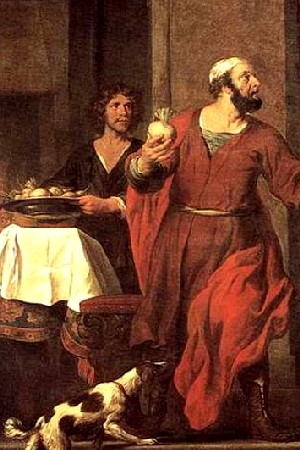
Artist: Govert Flinck
Marcus Curius Dentatus Preferring Turnips to Gold (1656)
According to Lémery, the Paracelsian principles include "much Oil, and a little essential Salt. They agree at all times, with young bilious persons, and those whose Humours are sharp and thin, provided however they have a good Stomach."23
Medicinally, Woodes Rogers said that on Juan Fernandez, they found "Store of Turnip-Greens, and Water-Cresses in the Brooks, which mightily refresh’d our Men; and cleans’d ‘em from the Scurvey"24. Turnip greens are indeed a rich source of Vitamin C and would have helped fight scurvy from those who ate it.25 Tryon says that a turnip "removes Obstructions which lie in the' Passages, makes the Belly soluble, and mightily helps Concoction by its moist and slippery kind of Quality"25. In contrast, Lémery says turnips "are windy, cause Obstructions [in the digestive tract], and are hard of digestion."26 All the botanists note this 'windy' property. Turnips are cruciferous vegetables which contain a lot of fiber. According to modern authors, this "can also make them hard to digest. It will be easier on your stomach if you cook them instead of eating raw."27 In fact, Gerard mentions that when "boiled in water,or in a certain broth, it is more moist,and sooner descendeth, and maketh the body more soluble, but rosted or baked, it drieth, and ingendreth Iesse winde, and yet it is not altogether without wind"28.
Physician John Pechey says that liquid turnips are boiled in can cure Quartan-Agues (malarial fevers that recur every four days). When roasted, "and applied behind the Ears, they cure the Head-ach, and the Pain of the Teeth. They are applied to Ulcers of the Legs, and to Swellings of the Breast, and for Scrophulous [believed to be caused by corrupt humors] and Scorbutic Tumours, with good Success."29 Gerard cites Dioscorides as his source for using crushed turnip "with good successe applied upon mouldy or kibed [chapped or cracked] heeles, and that also oile of Roses boiled in a hollow turnep under the hot embers doth cure the same."30
1 John Baltharpe, The straights voyage or St Davids Poem, 1671, p. 64; Edward Barlow, Barlow's Journal of his Life at Sea in King's Ships, East and West Indiamen & Other Merchantman From 1659 to 1703, p. 239; Edward Cooke, A Voyage to the South Sea and Round the World, Vol. 2, 1712, p. 60; William Dampier, A New Voyage Round the World, Vol III, 1703, p. 10 & 72; N. A. M. Rodger, The Command of the Ocean, A Naval History of Britain, 2006, p. 133; Woodes Rogers, A Cruising Voyage Round the World, 1712, p. 135; John Wood, "Captain Wood's Voyage Through the Streights of Magellan, &c.", A collection of original voyages, William Hacke, ed., p. 73; 2 N. A. M. Rodger, p. 133; 3 Baltharpe, p. 64; 4 Woodes Rogers, p. 135; 5 John Wood, p. 73; 6 Helen Sanderson, "Roots and Tubers", The Cultural History of Plants, Sir Ghillean Prance, Mark Nesbit, eds; 7 John Gerard, The Herball or General Historie of Plantes, 2nd ed, 1636, p. 231; 8 John Parkinson, Paradisi in Sole, Paradisus Terrestris, Reprinted from the Edition of 1629, 1904, p. 508; 8 Louis Lémery, A treatise of foods in general, 1704, p. 105; 10 Lémery, p. 106; 11 Parkinson, p. 509; 12 Lémery, p. 105; 13 John Evelyn, Acetaria, or a Discourse of Sallets, 1699, p. 70; 14 Parkinson, p. 509; 15 Thomas Tryon, The way to health and long life, 1697, p. 144; 16 Tryon, p. 145; 17 Gerard, p. 232; 18 Parkinson, p. 509; 19 Tryon, p. 145; 20 Evelyn, p. 71; 21 Gerard, p. 232; 22 Evelyn, p. 71; 23 Woodes Rogers, p. 135; 24 Megan Ware, "Everything you need to know about turnip greens", medicalnewstoday.com, gathered 1/4/23; 25 Tryon, p. 144; 26 Lémery, p. 105; 27 "Worst Foods for Digestion", webmd.com, gathered 1/5/23; 28 Gerard, p. 232; 29 John Pechey, the compleat herbal, 1707, p. 239; 30 Gerard, p. 232-3
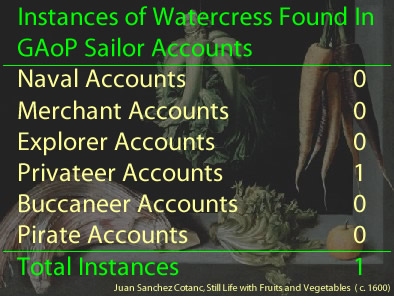
Watercress
(Nasturtium officinale)
Called by Sailors: Water-Cress
Vegetable Type: Salading
Appearance: 1 Time, in 1 Unique Ship Journey from 1 Sailor Account.1
Locations Found in Sailor's Accounts: Juan Fernandez Island, Chile;
Privateer Woodes Rogers mentions finding watercress when they stopped on Juan Fernandez Island in February of 1709. He doesn't provide any detail about them, however. Watercress is not native to Juan Fernandez "and might have been carried in accidently on the barrels used to collect and store water on board ships."2 It thrived there, however; when George Anson's fleet reached the island in 1741, they found "great quantities of watercresses and purslain, with excellent wild sorrel, and a vast profusion of turnips and Sicilian radishes"3.
Both botanists John Gerard and John Parkinson identify several types of watercress. Among those they mention are common, bitter, sweet-smelling and Italian watercress.4 The common watercress "hath many fat and weake hollow branches trailing upon the ...earth where it groweth, taking hold in sundry places as it creepeth... The leaves are Iikewise compact and winged with many small leaves set upon a middle rib one against another, except the point leaf, which stands by it selfe"5. Parkinson adds that the plant has "sundry broad sappy and almost round leaves, of a brownish greene colour, the flowers are many and white,
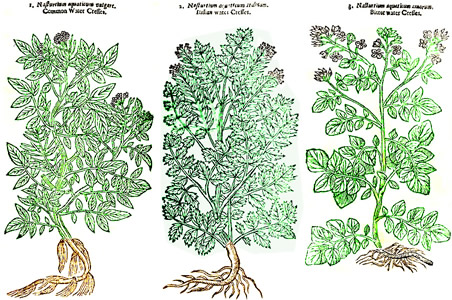
Common, Italian and Bitter Watercress, From Theatrum Botanicum the Theater of Plants,
By John Parkinson (1640)
standing on long footestalkes, after which come small yellow seed contained in small long pods like hornes"6. Parkinson is the only one to describe the bitter and sweet-smelling watercress. The first he says is larger than the common variety and has longer leaves, but is otherwise similar, except for the flavor. The sweet-smelling watercress lives up to the name he gives it, although he notes that it is smaller than the common. These are likely just variations of common watercress which becomes slightly bitter as it matures.7
What both botanists call Italian watercress is a different plant entirely. They each note that it is similar to common watercress but have crested stalks divided into multiple branches. "[T]he leaves are cut in a little here and there on the edges, and dented, somewhat resembling Parsley leaves"8. Because watercress has smooth-edged leaves, this is likely Fool's Watercress (Apium nodiflorum), a plant with the mentioned 'dents' in the leaves which tastes more like carrot than cress.9
Speaking of the flavor,
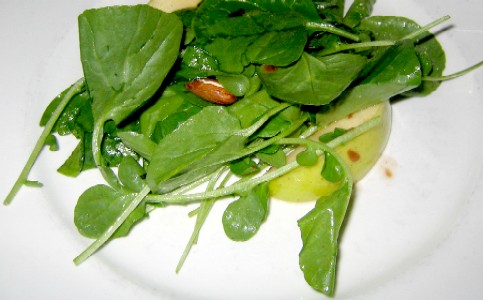
Photo: Bonjwing Lee - Watercress Salad with Spinach, Apples and Almonds
French botanist Lewis Lémery suggests watercress are more pleasant and less pungent than regular cresses.10 Parkinson says common watercress "tasteth somewhat hot and sharpe like [garden] Cresses", agreeing with Lémery's assessment. He says the bitter watercress is "is so extreame bitter in taste, that none can away with it to eate it unlesse it be boyled in water, and shifted againe into other fresh boyling water, to take away the bitternesse, and so some doe eate it"11.
As food, Lémery advises selecting watercresses which "are new, tender, small, and well tasted."12 Gerard suggests it is best when it first appears13. This is not surprising because watercress becomes more bitter as it matures. The botanists indicate the primary use of watercress leaves is raw in salads. In addition, physician John Pechey mentions, "'Tis much used in the Spring-time [when young in England], in Broths"14. Gerard similarly notes that it can be "chopped or broiled in the broth of flesh"15.
Humorally, "Water-Cresse is evidently hot and dry."16 All the authors suggests that it purifies the blood, one of the bodily humors. In fact, watercress is now known to contain dietary nitrates which combat inflammation and decrease blood vessel stiffness and thickness. This reduces blood pressure and increases antioxidants which can reduce the risk of heart problems.17 Lémery says the Paracelsian principles of the watercress include "much Oil, essential Salt, and Phlegm." He goes on to say that it is conducive "in Winter Time,
with old People, phlegmatick [having a cold and wet humoral temperaments] and melancholy [cold and dry]
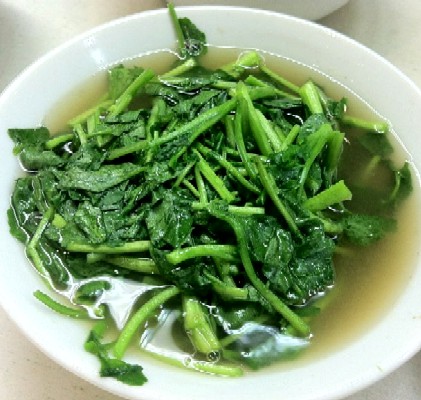
Photo: Walter Lim - Simple Watercress Soup
Persons, and all those whose Humours are gross,
and have but little motion." This, he explains is because watercress contains "a sharp Salt, that is very cutting and penetrating, and can rarifie the gross Humours, dissolve and attenuate the viscous juices, and produce all the good effects we have attributed thereunto." However, he also warns that consuming too much of it will "put the Humours into too violent an agitation"18.
Medicinally, the botanists and physician all suggest that watercress is useful in treating scurvy. "In short, we see daily that Scorbutick People are relieved by the use of them; and this makes it to pass among the most efficacious of antiscorbutick Remedies."19 Woodes Rogers states that the watercress they found on Juan Fernandez, along with turnip greens, "mightily refresh’d our Men; and cleans’d ‘em from the Scurvey"20. In fact, watercress contains a lot of vitamin C, making it a very effective 'cure'.21
Several other uses are identified by the period authors. Everyone mentions that it stimulates urine making it good for washing out kidney stones. Gerard recommends boiling it in milk or wine to make it even more potent.22 Pechey suggests using watercress to treat dropsy [edema].23 Lémery says that it causes sneezing,24 which was one of the bodily fluid discharges thought to be useful in balancing the humours. Parkinson notes that a decoction can be made from watercress which
is said to be good to wash foule and filthy Ulcers, thereby to clense them and make them the fitter to heale: The leaves or the juice is good to be applyed to the face or other parts troubled with freckles, pimples, spots or the like at night, and taken away or washed away in the morning, the juice mixed with vinegar, and the forepart of the head bathed therewith is very good for those that are dull and drowsie, or have the Lethargy.25
1 Woodes Rogers, A Cruising Voyage Round the World, 1712, p. 135; 2 Lyndon Wester, "Invasions and extinctions on Masatierra (Juan Fernandez Islands): a review of early historical evidence", Journal of HIstorical Geography, 17, 1 (1991), p. 30; 3 Richard Walter, A Voyage Round the World, 1748, p. 117; 3 See John Gerard, The Herball or General Historie of Plantes, 2nd ed, 1636, p. 256-7 & John Parkinson, Theatrum Botanicum the Theater of Plants, 1640, p. 1238; 5 Gerard, p. 257; 6 Parkinson, p. 1238; 7 "FAQ - Cooking and Eating Watercress", watercressfarms.com, gathered 1/2/23; 8 Parkinson, p. 1238; 9 "Fool's Watercress", WildFoodUK.com, gathered 1/2/23; 10 Louis Lémery, A treatise of foods in general, 1704, p. 94; 12 Parkinson, p. 1238; 13 Gerard, p. 258; 14 John Pechey, the compleat herbal, 1707, p. 61; 15,16 Gerard, p. 258; 17 Melissa Groves, "10 Impressive Health Benefits of Watercress", healthline.com, gathered 1/3/23; 18,19 Lémery, p. 95; 20 Rogers, p. 135; 21 "Health Benefits of Watercress", webmd.com, gathered 1/3/23; 22 Gerard, p. 258; 23 Pechey, p. 61; 24 Lémery, p. 96; 25 Parkinson, p. 1240
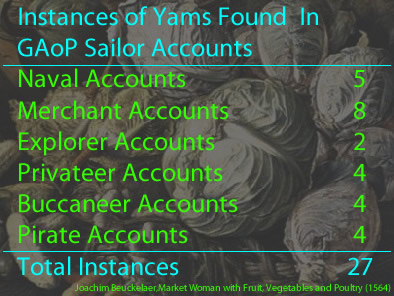
Yams/Sweet Potatoes
(Dioscorea/Ipomoea batatas)
Called by Sailors: Yam, Yamm
Vegetable Type: Root
Appearance: 27 Times, in 19 Unique Ship Journeys from 12 Sailor Accounts.1
Locations Found in Sailor's Accounts: Madiera, Portugal; Monrovia, Libya; Sierra Leone, Africa; Cape Coast Castle, Africa; São Tomé, Príncipe, and Annobón; St. Helena; Ile Ste. Marie, Madagascar; Nancowry & Thalassery, India; Trengannu, Malaysia; Banda Aceh & Pulau Buton, Indonesia; Marianas Islands; Batanes & Mindanao, Philippines; Haiphong, Vietnam; Fulleborne, New Britain; Guam; Barbados; Panama; Salvador, Brazil;
Yams are tubers native to Africa (Dioscorea rotundata), Asia (Dioscorea alata) and the Americas (Dioscorea trifida).2
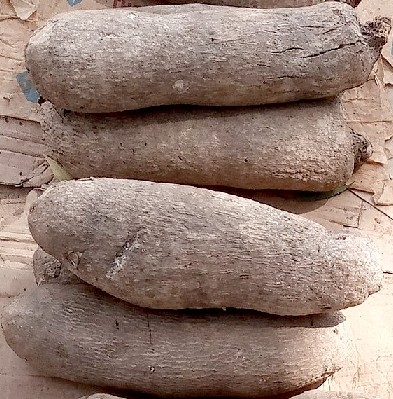
Photo: Wiki User Dnshitobu - African Yam Tubers
According to food historian Jessica Harris, when slaves were brought to the Caribbean, some slavers brought yams from Africa to feed them. Unfortunately, the African yam didn't grow well in the Americas so the sweet potato (Ipomoea batatas) took its place.3 Although similar to sweet potatoes, yams tend to be starchier and drier. Sweet potatoes are generally classified as 'firm' or 'soft'. Since the African slaves thought the soft sweet potatoes resembled the yams in Africa, they called them yams.4
Naval physician Hans Sloane describes what he found in Jamaica at the beginning of the eighteenth century as "Volubilis nigra, radice alba aut purpurea maxima, tuberosa, esculenta, farinacea, caule membranulis extantibus alato", which is Latin for "Black Volubilis, with a large white or purple root, tuberous, edible, farinaceous [starchy], winged stem with protruding membranes"5. This, combined with his description, suggests he is talking about the yam Dioscorea trifida. The African yam Dioscorea alata is sometimes purple as are some varieties of American yam Dioscorea trifida and sweet potatoes native to Central America.6 It is likely that African yams were largely abandoned by this time, being difficult to grow in the New World. So the yams encountered in the Caribbean during this period by sailors were either native American yams (Dioscorea trifida) or sweet potatoes.
Yams and sweet potatoes are the third most popular vegetable in the list, appearing in the every type of sailors account. Some sailors describe them, suggesting they were 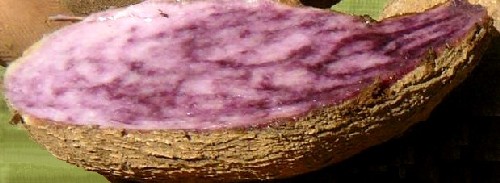
Purple Yam Tuber
unfamiliar. When Edward Barlow was sailing on HMS Monck in 1671, he found them on St. Helena, where he notes that a yam is "a thing much like a potato, but far bigger."7 Francis Rogers gives a similarly brief description of a yam as "a large thick root" when he came across one in the same place in June of 1703.8 Sloane describes those found on Jamaica as "a Foot or more long, Brown on the outsides, with several
long Fibers, running out on all sides to draw its Nourishment. It is very
thick, sometimes roundish, being within viscid... and of
a white, or reddish purple colour... of the bigness of ones Leg or Thigh."9 These are almost certainly yams based on his description of the 'fibers' on the outside of the vegetable. Botanist John Parkinson describes sweet potatoes as "like in shape and forme unto Asphodill [genus Asphodelus] rootes, but much greater
and longer, of a pale browne on the outside, and white within, set together at one
head"10 .
While sailing in the captured vessel Marquis of Woodes Rogers privateer fleet, captain Edward Cooke gives
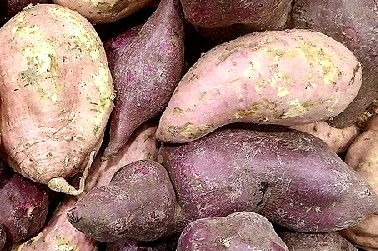
Photo: Wiki User Filo gén - Red and White Sweet Potatoes
the cost of yams and/or sweet potatoes at Guam in March of 1710. There, the fleet purchased "250 Baskets of Yams and Patatas, at 4 R[eales]. per Basket"11.
Yams/sweet potatoes appear in several pirate accounts, although two of these are from descriptions of São Tomé, Príncipe, and Annobón given as background by navy surgeon John Atkins in the General History of the Pyrates. He notes that Principe has "Valleys with fruitful Plantations of Yamms", among other vegetables.12 However, pirate Richard Luntly states that, in addition to other foods, they obtained "Yams and Putato, in which [Bartholomew Roberts' pirates] made those Natives supply them with as much fresh Stock as supplied us to the Coast of Brazile"13. Adam Baldridge mentioned that pirate captain Edward Coats careened by his outpost on Ile Ste. Marie, Madagascar in October of 1692 where "the Negros [supplied them] with fowls, Rice and Yams"14.
A couple sailor's accounts discuss the flavor of yams. The privateer St. George stopped at what was probably Magon in the Mariana Islands in 1705 where William Funnell reported, "several fishing Boats came to us, and brought us …Yams, Potatoes, &c. and These were very acceptable to us"15. When the East Indiaman Kent stopped at
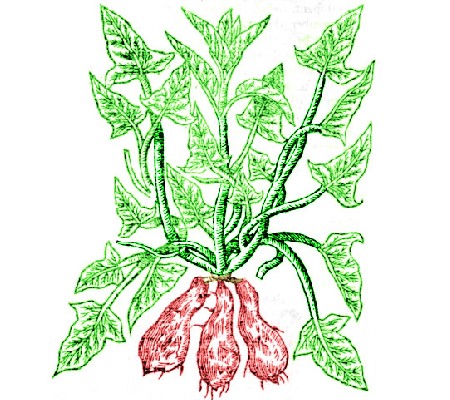
Sweet Potato Plant, From Paradisi in Sole, Paradisus Terrestris, John Parkinson (1629)
Tellicherry (modern Thalassery), India in 1685, Barlow mentioned that yams "are not much unlike potatoes in eating"16. Rogers describes both potatoes and yams as being
"boiled and eat instead of bread, tasting between a potato and an artichoke bottom, but tuff to the palatte."17 Captain Alexander Hamilton reported that in 1705 when he was at Nancowry Island off India, where the locals brought them "dried Yams, the best I ever tasted"18. Physician William Hughes says of the yams he found in Jamaica, "These are very good Roots, and are common ordinary food amongst Planters and do nourish very well, but not so much as the Potatoes do, neither are they so delightful in taste, but agree very well with the Inhabitants... these roots are ordered and dressed as Potatoes are"19. Fellow physician Hans Sloane says the yams he found in Jamaica"are eaten as Bread, being rosted under the Fire, or boiled, being very mealy. They are eaten likewise with Pepper and Oil, and or Bread in Guiney [Africa]."20
Talking about sweet potatoes (which he simply calls 'potatoes'), botanist John Gerard says they are
among the Spaniards, ltalians, lndians, and many other nations, ordinarie and common meat [food, and] ...are used to be eaten rolled in the ashes. Some when they be so rosted infuse and sop them in wine: and others to give them the greater grace in eating, do boile them with prunes and so eat them: likewise others dresse them (being first rosted) with oile, vineger and salt every man according to his owne taste and liking:"21.
Fellow botanist Parkinson notes that sweet potatoes (which he calls 'Spanish potatoes')
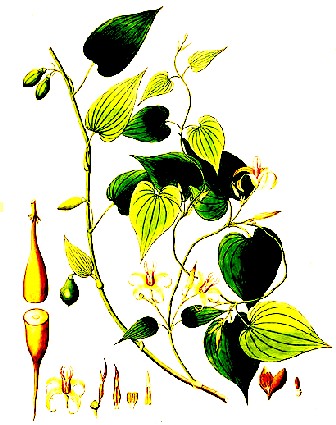
Yam Plant, From Plants of the coast of Coromandel Coast,
By
William Roxburgh (1795)
are "firme and verie sweete"22. He adds a recipe that borders on a familiar use of sweet potatoes today: "Spanish Potato's are roasted under the embers, and being pared or peeled and sliced, are put into sacke with a little sugar, or without, and is delicate to be eaten."23 Physician Sloane agrees they are roasted under ashes, being "thought extraordinary
good and nourishing Food, and because of their speedy attaining their due growth and perfection, they are believed to be the most profitable sort of Root for ordinary Provision."24
In addition to the typical recipes for these roots, navy sea surgeon John Atkins says that the residents of Barbados use potatoes to "make a brisk Small beer, called Mobby."25 Sloane mentions that on Jamaica, sweet potatoes "are used in great quantities to make the Drink called Mobby."26 John Taylor, who lived in Jamaica for about six months in 1687, says that mobby "is a plesant cold liquor" which was one of their 'cheife' drinks.27
Gerard is the only person to comment on humoral properties of these plants. Of the sweet potato, he says, "The leaves of Potato's are hot and dry, as may evidently appeare by the taste: the roots are of a temperat qualitie."28 This is interesting in that it suggests that sweet potato roots have little or no impact on the bodily humors.Sloane talks about the medicinal properties of yams, citing the seventeenth century botanical treatise Hortus Malabaricus as his source. "The Juice of the Leaves is good against Scorpions biting. The Root powdered with Catu-panna-Kelengu [probably Kappa-kelengu or sweet potatoes] is strewed on malignant Ulcers, with good success, and used in Fomentations."29 John Gerard says that sweet potatoes "comfort, nourish,and strengthen the body, vehemently procuring bodily lust."30 This should not be entirely surprising, given that he says they have limited impact on bodily humors. Sloane cites Dutch physician Willem Piso's opinion that sweet potatoes are 'windy' and Italian historian Peter Martyr of d'Anghiera's assertion, "They are very nourishing and provoke to venery [lust]."31
1 John Atkins, A Voyage to Guinea and Brazil, 1735, p. 26, 48 & 59; Edward Barlow, Barlow's Journal of his Life at Sea in King's Ships, East and West Indiamen & Other Merchantman From 1659 to 1703, p. 81, 199, 312 & 375; Edward Cooke, A Voyage to the South Sea and Round the World, Vol. 2, 1712, p. 9; William Ambrosia Cowley, "Cowley's Voyage Round the Globe", A collection of original voyages, William Hacke, ed., 1993, p. 16; William Dampier, A New Voyage Round the World, 1699, p. 12, 311, 426 & 455; Dampier, "Part 1", A Supplement to the Voyage Round the World, 1700, p. 22 & 126; Dampier, A New Voyage Round the World, Vol III, 1703, p. 72; Dampier, A Continuation of a New Voyage Round the World, Vol III, 1709, p. 143; Pirates in Their Own Words, Ed Fox, ed., 2014, p. 123; William Funnell, A Voyage Round the World, 1969, p. 150 & 226; Alexander Hamilton, A New Account of the East Indies, 1746, p. 374 & 439; John Franklin Jameson, Privateering and Piracy in the Colonial Period – Illustrative Documents, 1923, p. 182; Daniel Defoe (Capt. Charles Johnson), A General History of the Pyrates, Manuel Schonhorn, ed., 1999, p. 179 & 183; Francis Rogers, "The Diary of Francis Rogers", Three Sea Journals of Stuart Times, 1936, p. 191; Nathaniel Uring, The Voyages and Travels of Captain Nathaniel Uring, 1928, p. 107; 2 "Yam (vegetable)", wikipedia.com, gathered 12/9/22; 3 Rosalind Cummings-Yeates, "Confusion and connection: The yams and sweet potatoes of the African Diaspora", thetakeout.com, gathered 12/9/22; 4 "What is the difference between sweet potatoes and yams?", Library of Congress website, gathered 12/8/22; 5 Darlene Schmidt, "What Are Purple Sweet Potatoes?", thespruceeats.com, gathered 12/9/22; 6 Hans Sloane, A Voyage to the Islands Madera, Barbados, Nieves, St Christophers and Jamaica, Vol1, 1707, p. 139; 7 Barlow, p. 199; 8 Rogers, p. 191; 19 Sloane, Vol. 1, p. 139; 10 John Parkinson, Paradisi in Sole, Paradisus Terrestris, Reprinted from the Edition of 1629, 1904, p. 516;11 Cooke, p. 9; 12 Atkins in Defoe [Johnson], p. 183;13 “27. Richard Luntly, from The Last Speech and Dying Words of Richard Luntly (Edinburgh, 1721”, Pirates in Their Own Words, p. 123; 14 Adam Baldridge, “63. Deposition of Adam Baldridge, May 5, 1699”, Privateering and Piracy in the Colonial Period – Illustrative Documents, John Franklin Jameson, ed., 1923, p. 182; 15 Funnell, p. 226; 16 Barlow, p. 375; 17 Rogers, p. 191; 18 Hamilton, p. 374; 19 William Hughes, The American physitian, 1672, p. 16; 20 Sloane, Vol. 1, p. 139; 21 John Gerard, The Herball or General Historie of Plantes, 2nd ed, 1636, p. 926; 22 Parkinson, p. 516; 24 Sloane, Vol. 1, p. 151; 25 John Atkins, A Voyage to Guinea and Brazil, 1735, p. 217; 26 Sloane, Vol. 1, p. 151; 27 John Taylor, Jamaica in 1687, David Buisseret ed, 2010, p. 217 & 237; 28 Gerard, p. 926; 29 Sloane, Vol. 1, p. 139; 30 Gerard, p. 926; ; 31 Sloane, Vol. 1, p. 151

